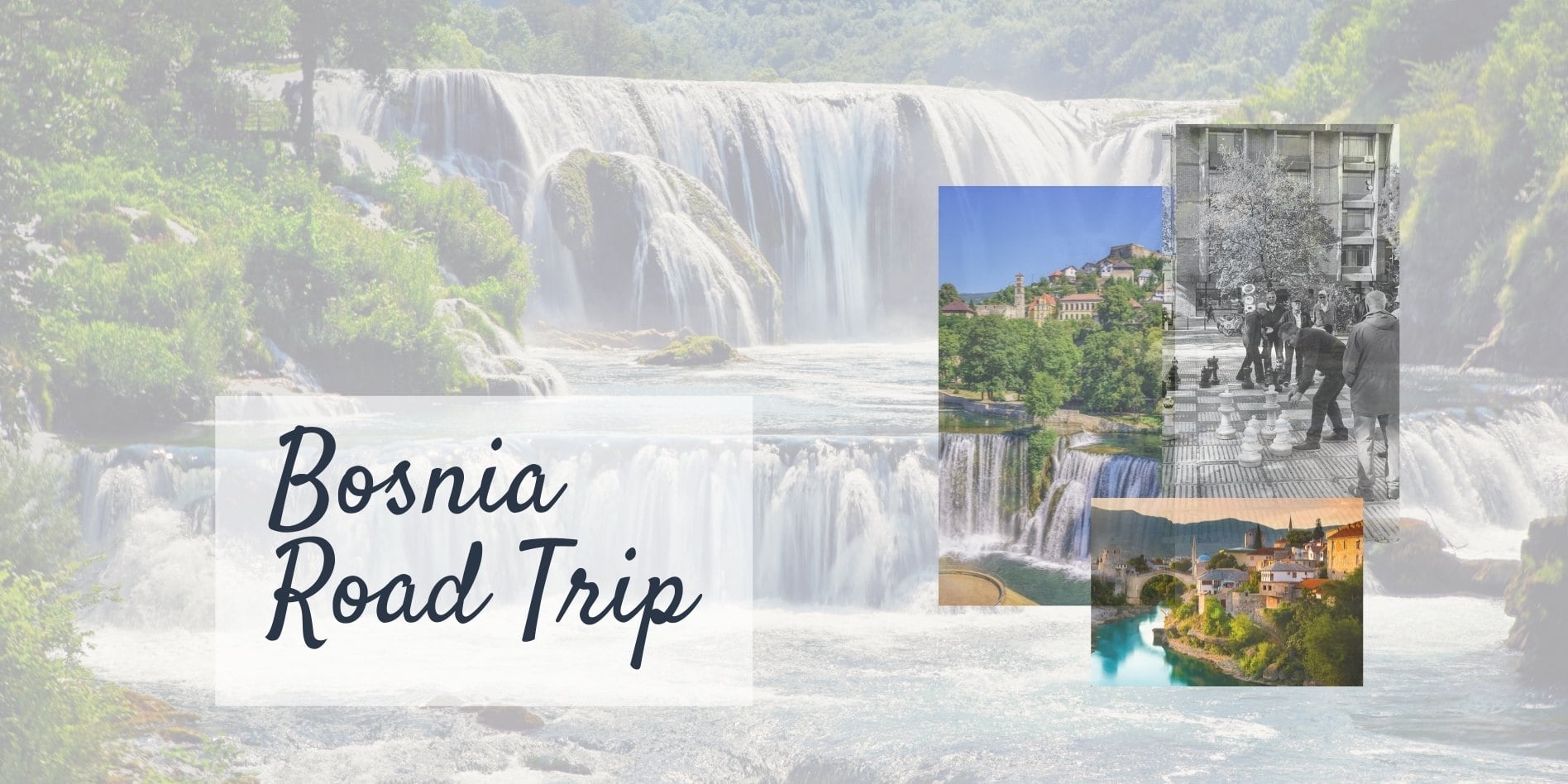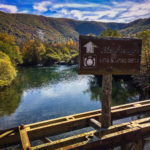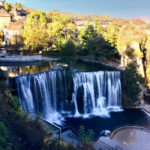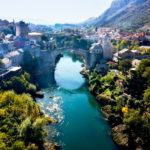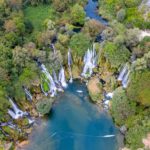Embark on a campervanning trip in Bosnia to experience a landscape where forests cover half the country. Picture-perfect scenes with waterfalls, mountains, lakes, and fruit-laden orchards await you.
The beautiful places we discovered while motorhoming in Bosnia were a delightful surprise and became one of our favourite stops on our European campervanning journey.
Bosnia and Herzegovina, referred to as Bosnia here, boasts a rich cultural and historical tapestry. This country, a melting pot of religions, has endured its share of conflicts.
Despite its history, the people of Bosnia—Bosniaks, Serbs, and Croats—are incredibly welcoming, with a strong sense of pride and community.
Bosnia became our next destination after exploring Croatia and visiting the famous Krka and Plitvice waterfalls.
Bosnia borders Croatia, Montenegro, and Serbia. It also boasts a small stretch of coastline on the Adriatic Sea in the southwest.
Overview of Places to Visit on a Motorhoming Road Trip in Bosnia
Summary of places to visit on a Bosnia road trip (we cover these in more detail with extra recommendations in the post – click on a place to find it in the post)
Bosnia Motorhome Road Trip Itinerary
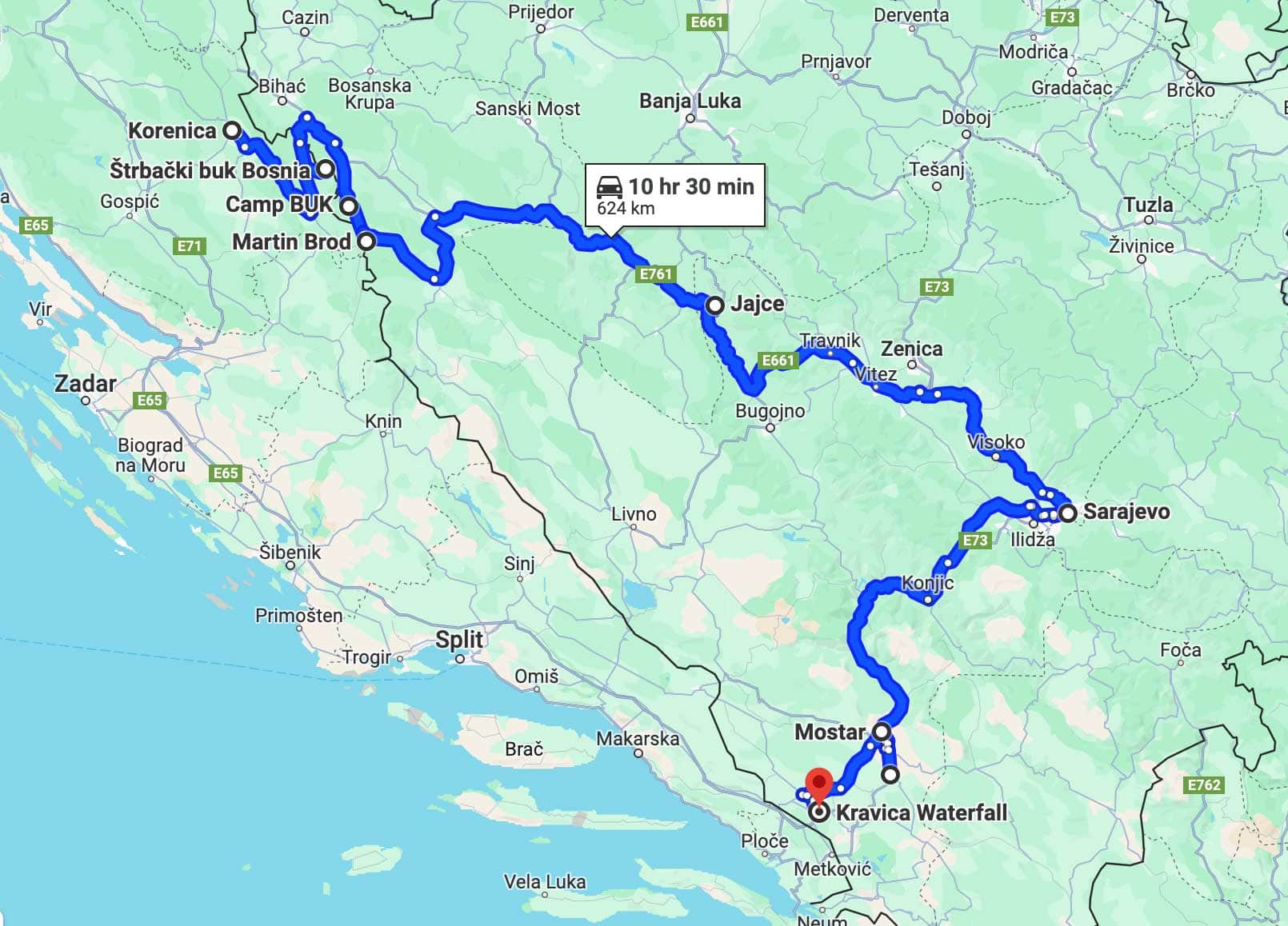
- Korenica > Strbacki Buk: 77 km (approx 1 hour 40 mins)
- Strbacki Buk > Camp BUK: 16 km (30 mins)
- Camp Buk > Martin Brod: 12 km (20 mins)
- Martin Brod > Jajce:150 km (2 hours 20 mins)
- Jajce > Sarajevo: 158 km (3 hours)
- Sarajevo > Camp Buna: 140 km (2.5 hours)
- Camp Buna > Mostar: 13 km (20 mins)
- Camp Buna > Kravica Waterfalls: 41 km (45 mins)
Bosnia Road Trip Total Kilometres: 624 kilometres (Approx 10 hours 35 mins driving time)
What’s Included in this Motorhoming in Bosnia Road Trip Post?
To help you plan your campervan trip in Bosnia, we have included the following:
Bosnia Road Trip Interactive Map
How to use this Motorhoming in Bosnia Map
To use this map, expand it using the square symbol on the top right-hand side and you will find the key on the left-hand side. By clicking each location you will find extra information. For example, each campervan/ motorhome/RV overnight park on the Map has the web link to Camper Contact where you can see the facilities available, price, opening times, and useful user reviews on each campsite.
You can also click or unclick the driving route for ease of use when viewing.
The motorhome overnight stops we used are marked with a brown circle and a motorhome icon and the places we visited are marked with purple icons.
Planning a Campervan Trip to Bosnia?
- 🚐 Hiring a campervan? We recommend Motorhome Republic
- ⛑ Arranged your travel insurance? Compare quotes from World Nomads & Safetywing
- 🪪 Order your International Driver’s Licence online here
- 🏩 Booked your accommodation? We use Booking.com to find the best deals
- 🐾 Is someone pet-sitting for you? 🐾 We use and love TrustedHousesitters
- (Get 25% off at checkout for new memberships with our discount code: LIFEJOURNEY25)
Video – A few seconds of Bosnian Moments on our Road Trip
Here’s a taster of our motorhome trip through Bosnia and Herzegovina.
Campervanning in Bosnia: Places To Visit
Our motorhome trip through Bosnia brought so many unexpected scenic views. With many waterfalls and National Parks and the surprising warmth of its people, this became one of our favourite European road trips.
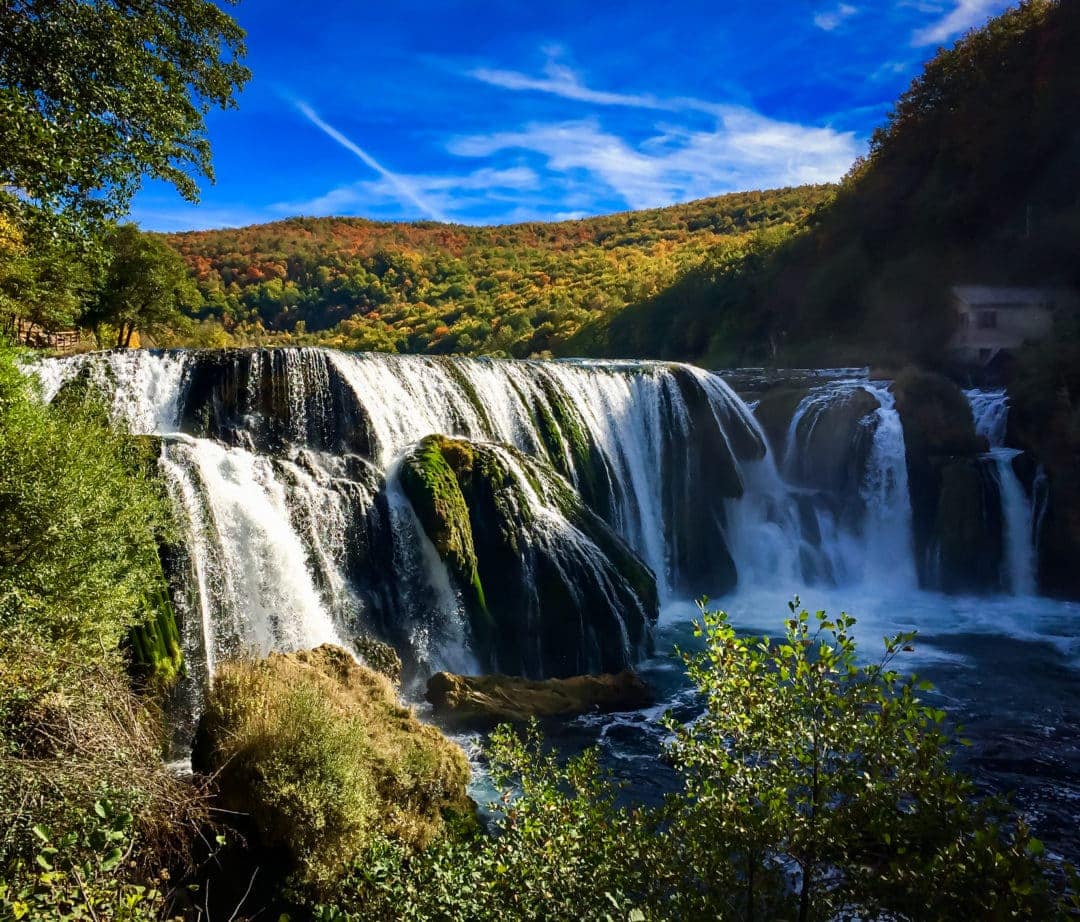
1. Una National Park
Any road trip throws up surprises, some more welcome than others. Una National Park involved both types. But it really is one of the most beautiful places on this campervanning Bosnia Road trip.
Strbacki Buk, waterfall in Una National Park
Our road trip to one of the main waterfalls in the Una National Park, Štrbački buk, began on what we call relatively normal roads.
However, with 8km still to go, we turned onto a rather rutted, unpaved road. Our buttocks jiggled up and down, along with everything else in the campervan that could wiggle and jump around.
Not imagining this could go on for the whole eight kilometres, we continued. Note to self — never overestimate the quality of a road on a Bosnia road trip.
Not only did the bumpy ride continue, but the road seemed to close in on us, so much so that in places, we wondered whether it might be a goat track rather than an actual road.
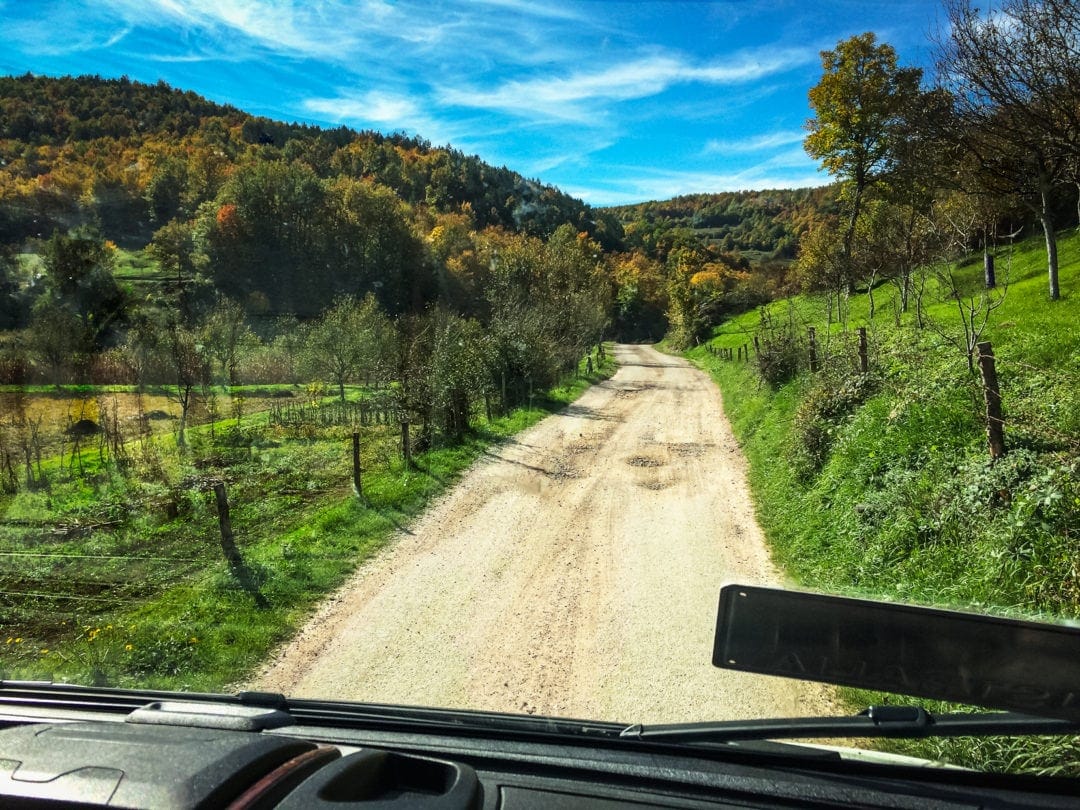
The road wound its way along, running parallel to the Una River. Emerald green water pools glimmering with leafy reflections flowed alongside us.
Apart from the moments we thought we might slip into it, the River Una was lovely.
The choppy track probably aged the motorhome by ten years (luckily, we were renting), and it gave Lars a few more grey hairs —keeping an 8-metre-long motorhome out of a river will do that to you.
But, the scenery was gorgeous. And, because we were travelling so slowly, Lars could enjoy it too — well, when the wheels weren’t skimming the water. There’s always a silver lining;)
When we finally arrived at Strbacki Buk, enduring every bump and jolt in the road seemed more than worth it.
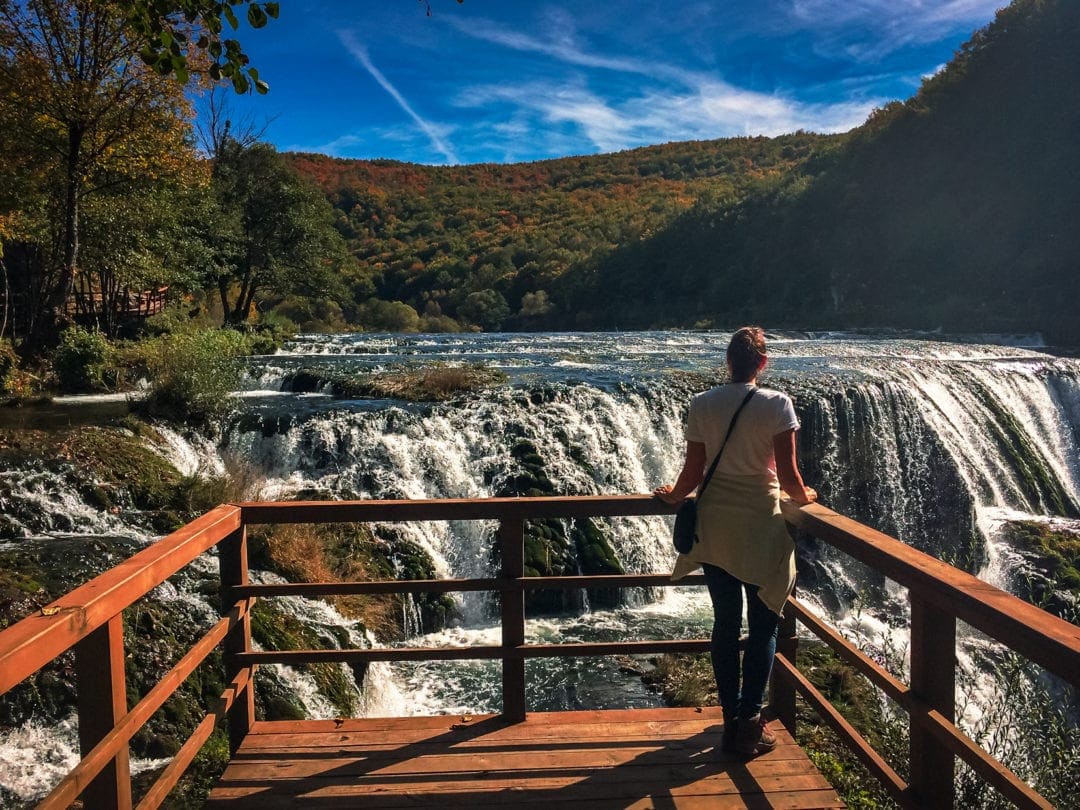
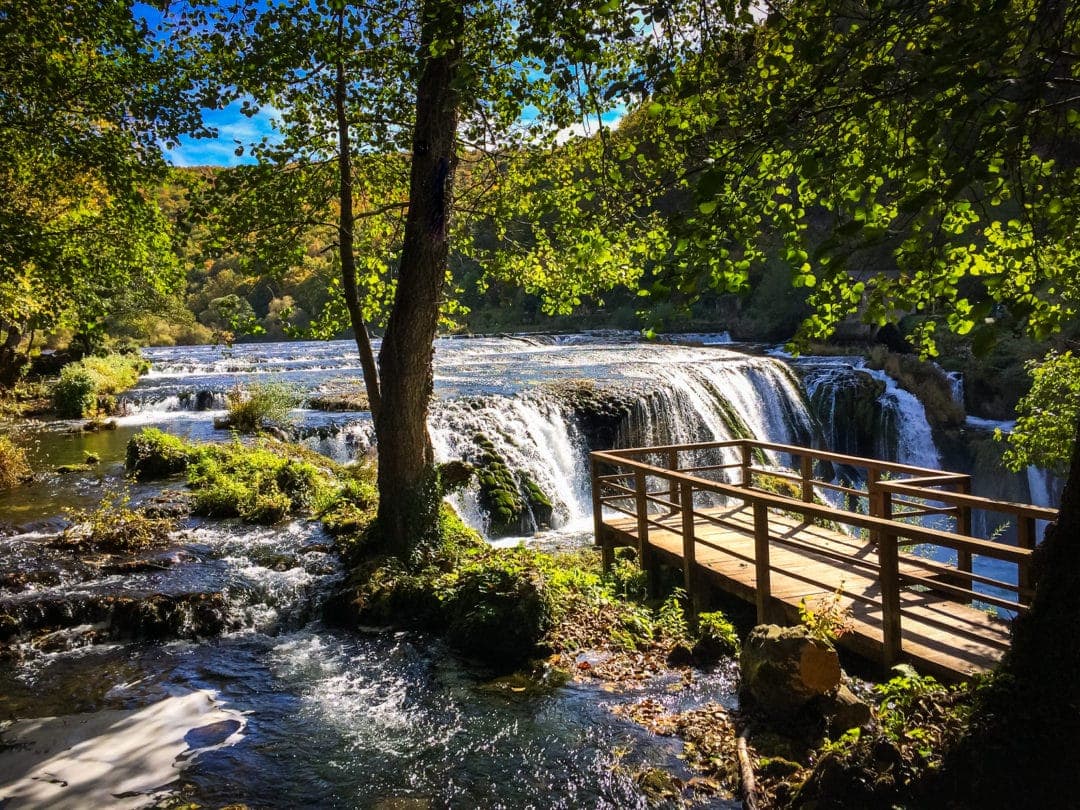
Una National Park, the largest park in Bosnia, was set up in 2008 to protect the Una River and its tributaries Krka and Unac. The park has several entrances, but to see the largest waterfall, Strbacki buk, the 8km dirt track is a necessary right of passage.
The Strbacki Buk waterfall is 25 metres high and an impressive sight. There are plenty of wooden bridges and platforms for easy viewing.
Martin Brod Falls in Una National Park
Another section of Una National Park is Martin Brod. The entrance is by Martin Brod village, and it’s really worth walking around this tiny village.
Mini waterfalls flow among the rustic homes, and it’s hardly surprising that this area used to be full of watermills and natural washing mills called bučnicas.
You can read more about Martin Brod from the Una National Park website.
Local legend tells us that the name Martin Brod came about after a young girl, Marta, tried to cross the river. Marta was in love with a curly-haired boy living on the river’s opposite side.
Unfortunately, her parents weren’t happy with this and forbade her from seeing him. One day, she tried to cross the ford (brod), but the rocks were so slippery that she fell into the rapids, never to be seen again.
The Ford was named after her, Marta’s Brod, eventually morphing into Martin Brod.
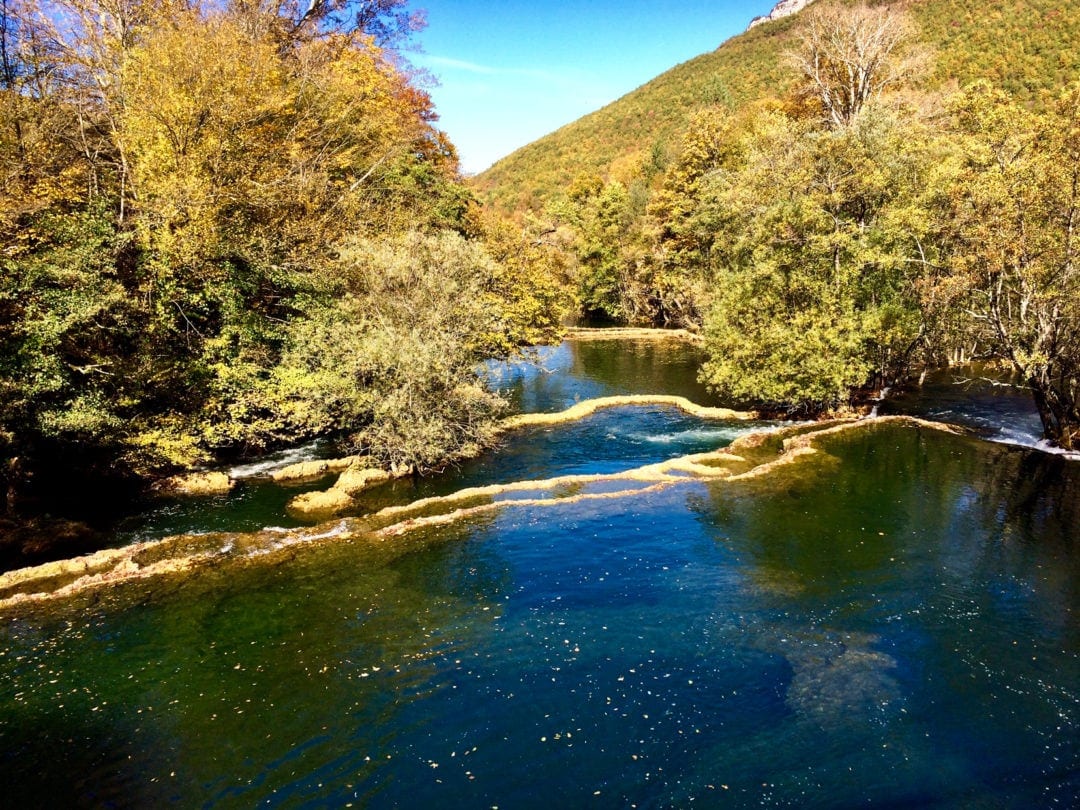
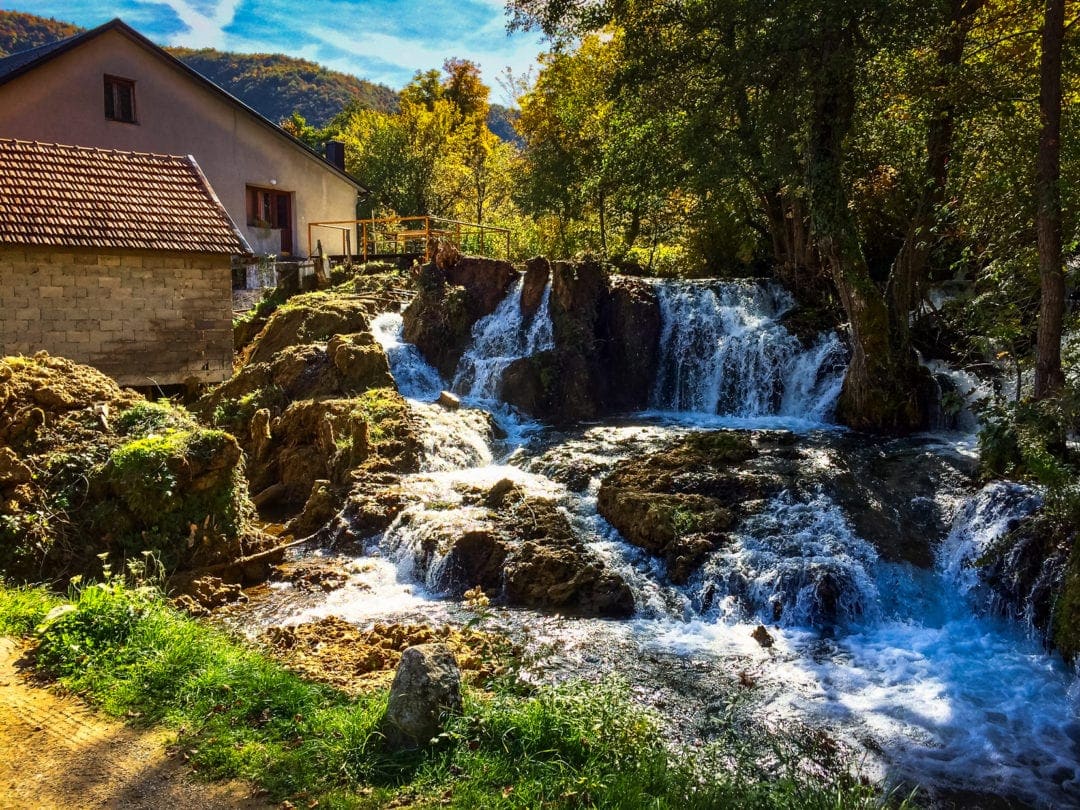
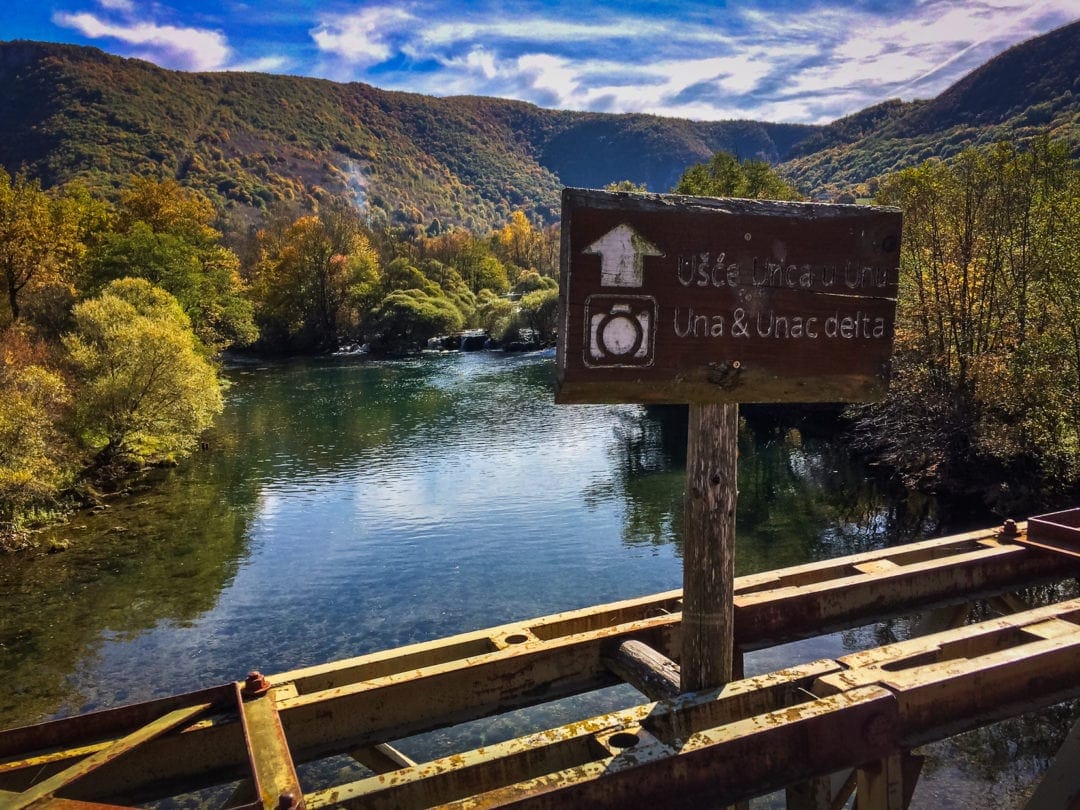
2. Jajce
While visiting Jajce on your Bosnian road trip, you’ll realise that the town is a little different from most. Rather than a central square as its centrepiece, Jajce has the Pliva Waterfall cascading 22 metres in the centre of town.
The walled city of Jajce was once the capital of the Kingdom of Bosnia. Built in the 14th century, it became the seat of the Bosnian Kings. Later, it became a citadel, and the Jajce fortress, along with the medieval watchtower, now crowns the town.
You can capture a fantastic high-ground shot of Pliva Waterfall from the other side of the river, along with Jajce’s clock tower and fortress in the background.
Directions for great photography spot: From the bus car park (see brown motorhome stop on the above map), cross the bridge on the E761, turn left onto the M16, pass an old cemetery on your right and on your left you’ll see a path into the woods leading to a wooden pavilion.
From there you will have a fantastic view.
(Unfortunately, we didn’t know this at the time, so all our shots are from below)
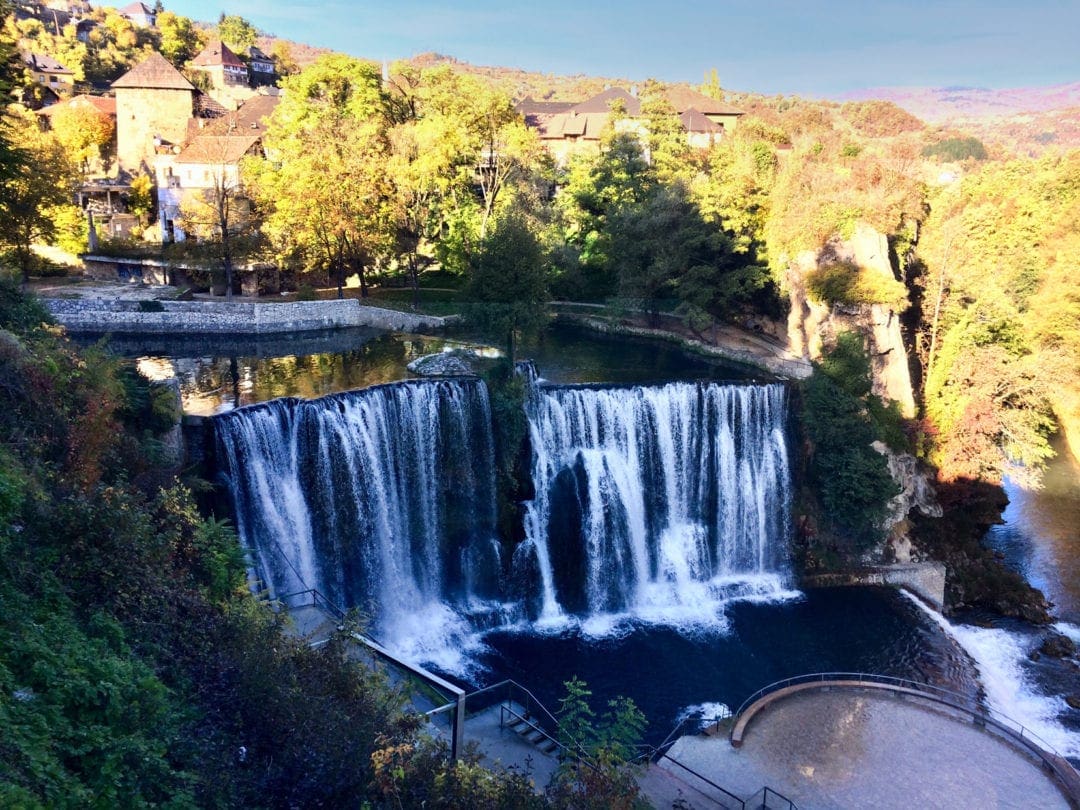
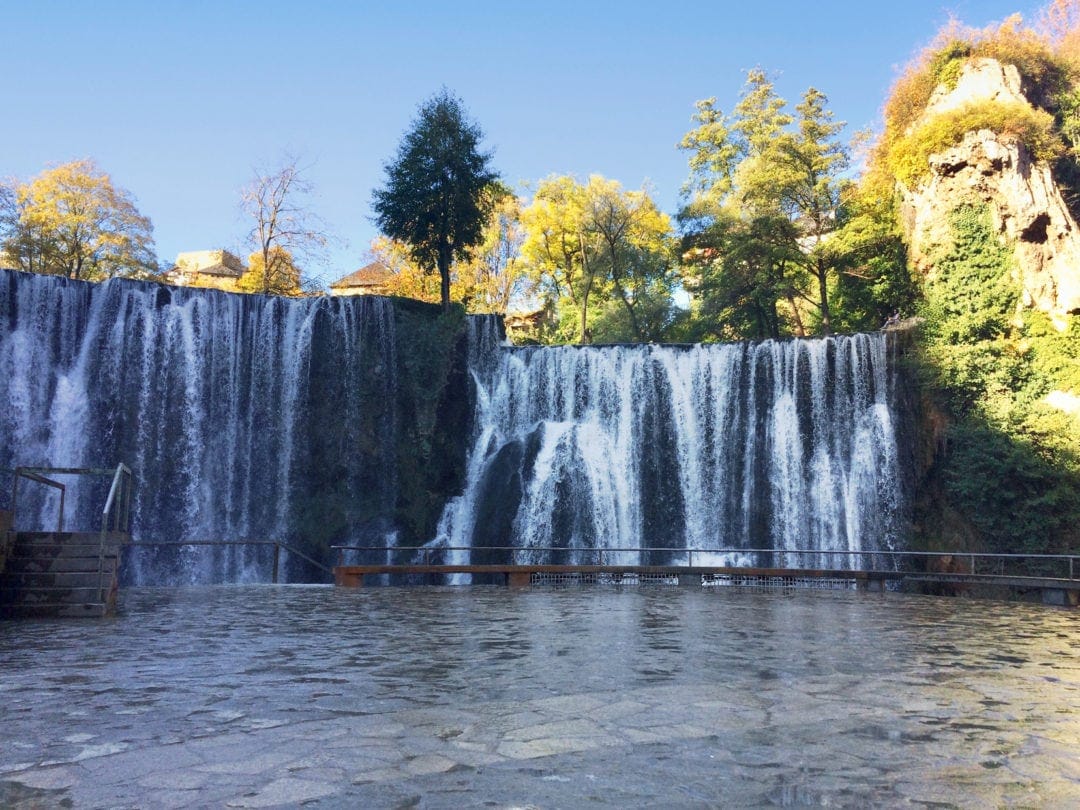
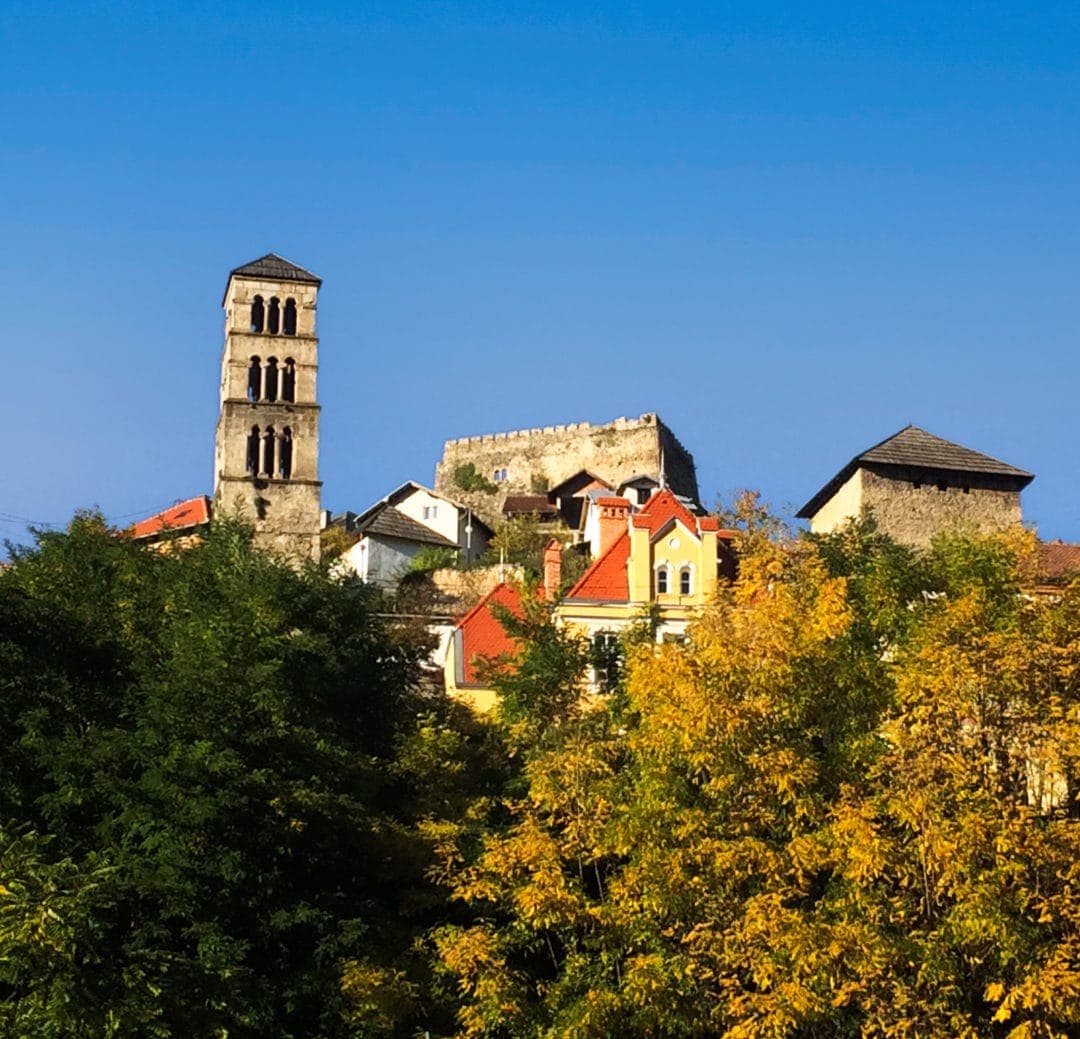
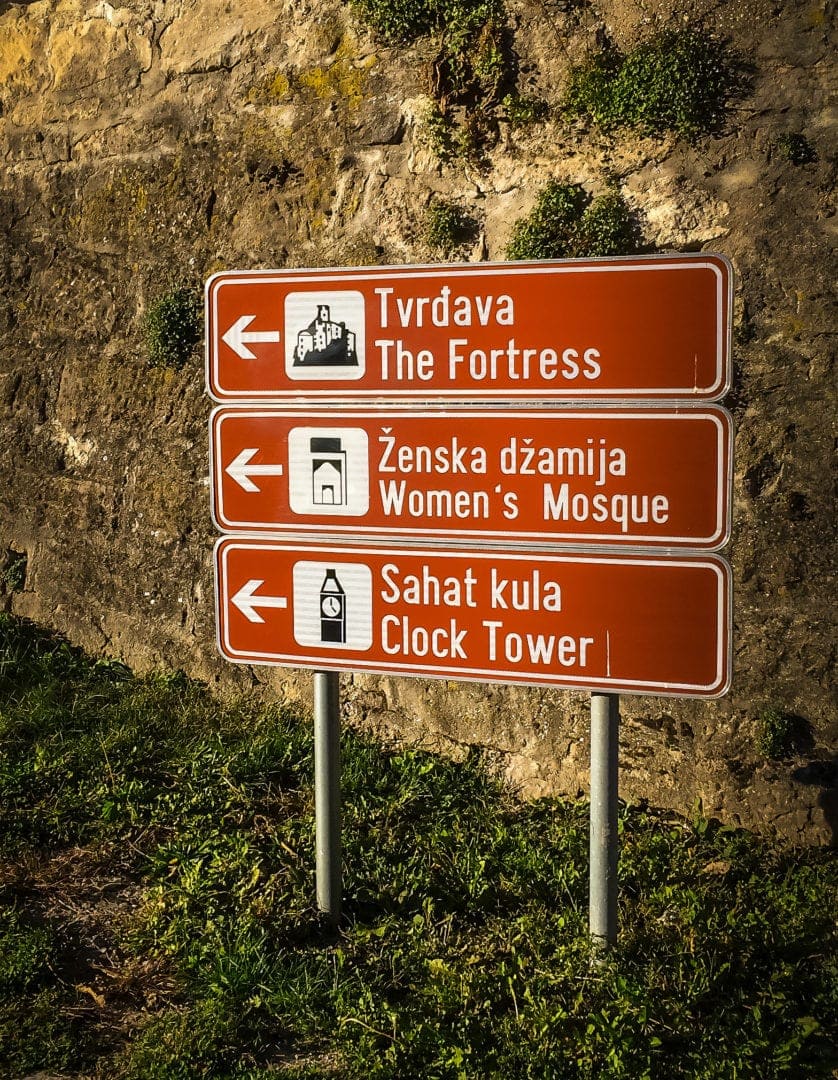
Jajce Wooden Watermills
About 5km west of Jajce, Mlinčići Park is a marvellous park where you can stroll around the waterfalls and catch a glimpse into the watermill history of Jajce.
Water cascades around these old wooden mills surrounded by greenery. A picturesque spot to stop with Pliva Lakes close by.
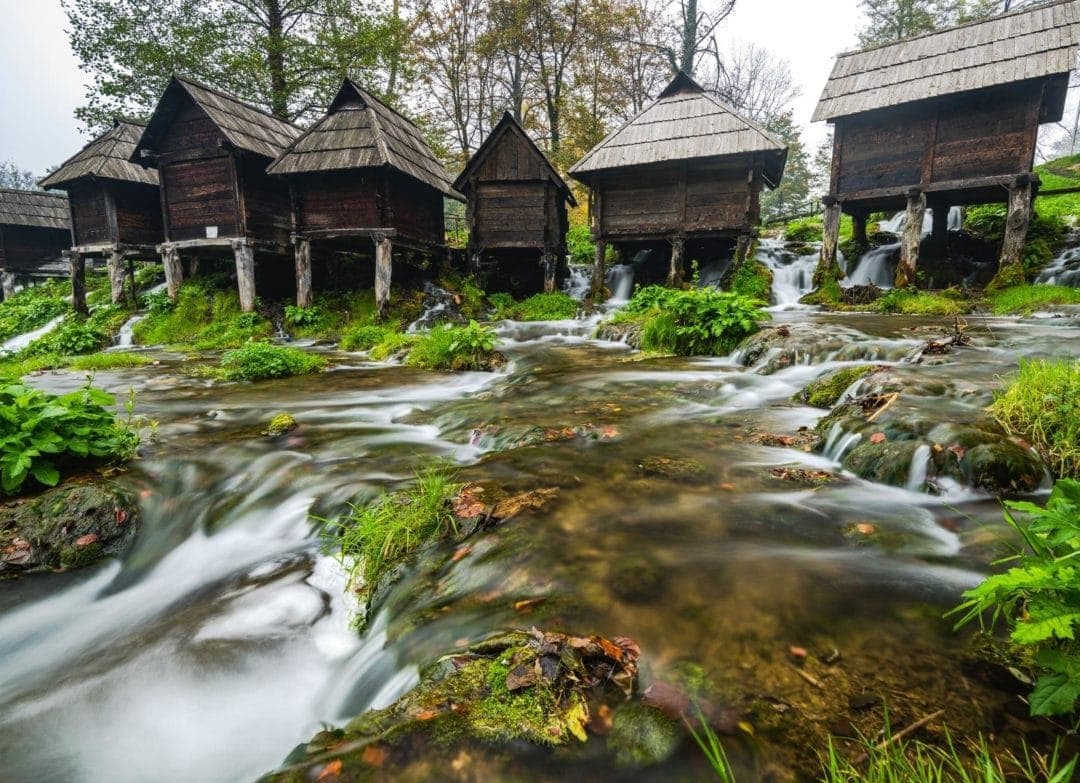
3. Sarajevo
Leaving Jajce behind, the next stop, as we road-tripped Bosnia, was Sarajevo.
Bosnia and Herzegovina’s capital city, Sarajevo, bears deep scars from the 1992-95 Bosnia War. Some are visible, but many are unseen, carried in the hearts of its people. Sarajevo suffered 44 months of constant siege. 11,500 were killed, and 1600 of those were children.
It was the longest siege of a capital city in the history of modern warfare.
Thanks to my history lessons at school, Sarajevo was one of the cities I had heard of. I’m not sure I actually knew where it was, but I knew the assassination of Franz Ferdinand happened here in 1914 and that it caused World War One.
I don’t remember learning the whys and wherefores of it all, but at least I knew that.
When Sarajevo hosted the Winter Olympics in 1984, I was 17 years old. Not being much interested in sport, I can’t say I learned any more about where it was then either.
Now, walking side by side with Neno, our tour guide and a young man who grew up during the siege of Sarajevo, I feel guilty that his city and his plight weren’t ever in my mind.
How detached we can become as we busy ourselves with living our own lives.
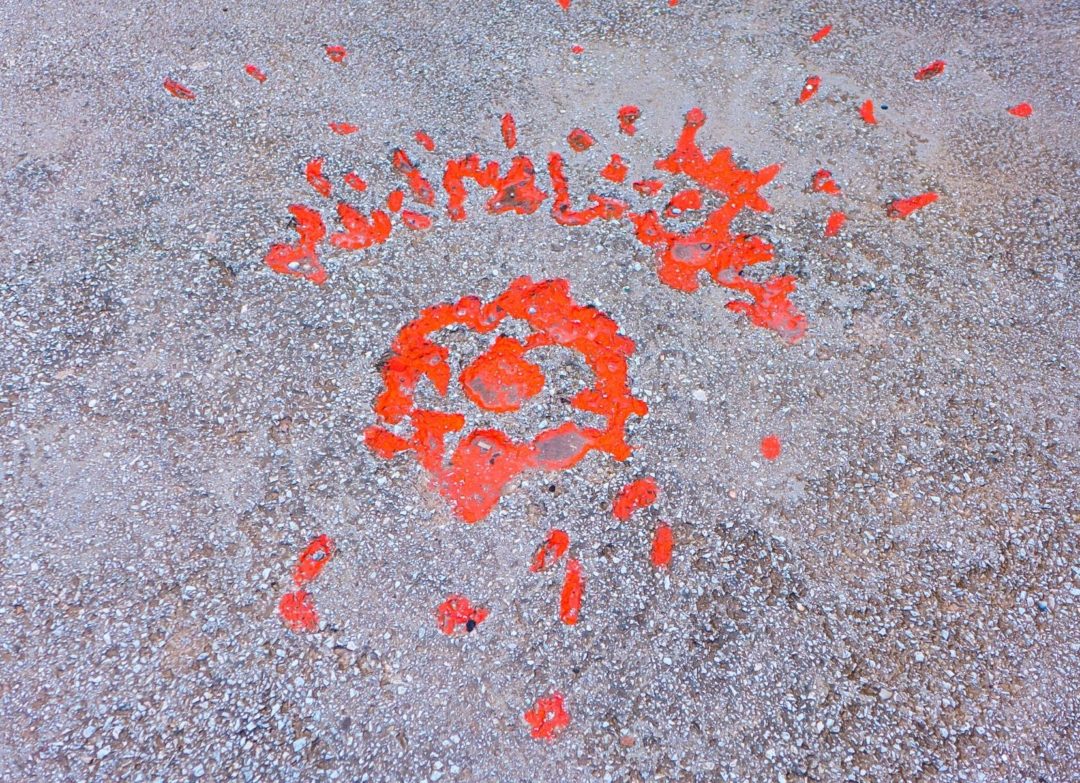
When Neno was sheltering and living in the basement of his building with all the other families, I was studying law at university.
While I worried, as a divorced, single mum, how I would complete my assignment with a two-year-old toddler throwing tantrums left, right and centre, Neno watched on as friends and family were shot and killed by snipers and mortar shell explosions.
I worried about assignments. He worried about getting enough food, enough clean water and getting through a day without losing a loved one.
Every day.
For 1425 days.
The concrete scars left by mortar bombings throughout Sarajevo have been painted in a red resin as a legacy to those who were killed in the Sarajevo siege. They are known as the Sarajevo Roses.
Whatever you choose to do in Sarajevo, do choose to take a tour and hear the stories of those who lived through the war. We recommend Neno and friends Free walking Tour (It’s free, but you tip the amount that you would like to give at the end).
Liberation Square (Trg Oslobođenje)
Liberation Square is in the heart of Sarajevo. Nearby, as a nod to the city’s multiculturalism, are Cathedrals—one Orthodox, another Christian, a Jewish Synagogue, and a Muslim Mosque.
A blended community.
Unbroken by a conflict that could have very easily trampled its soul.
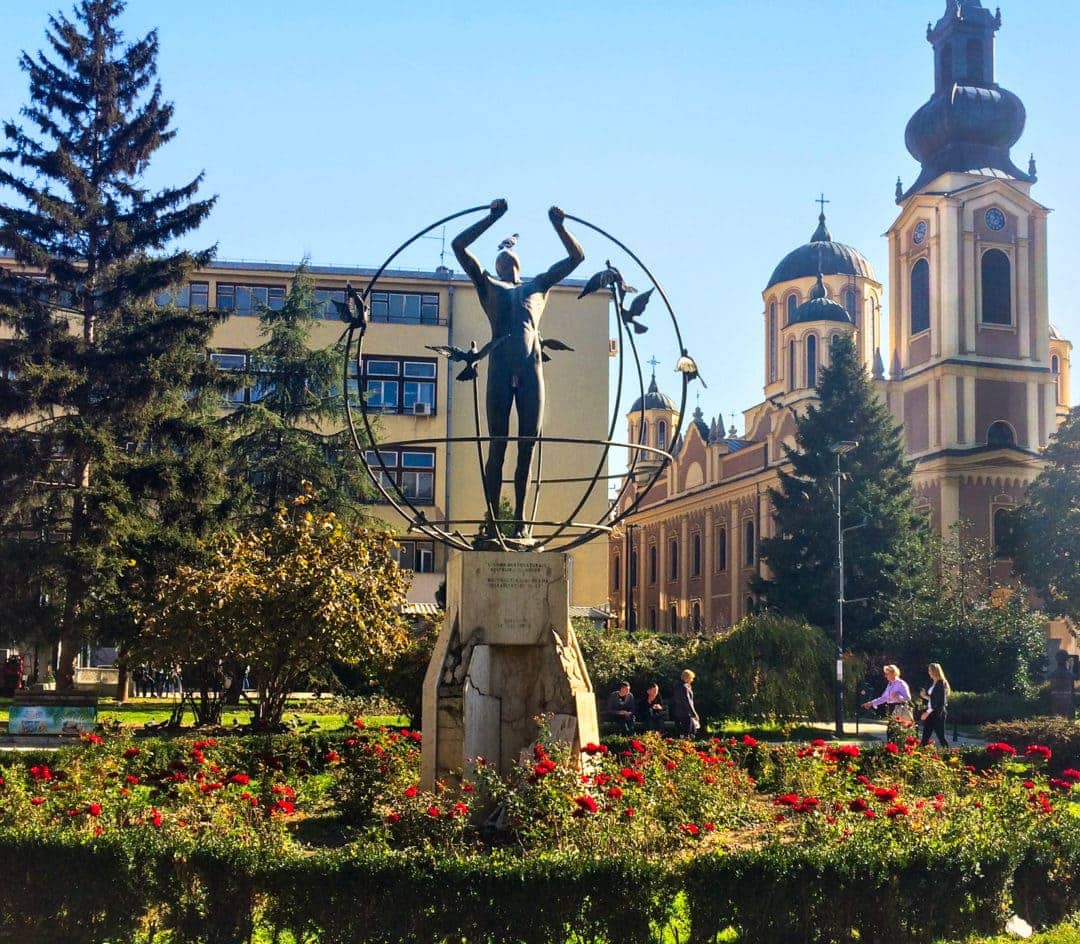
Listening to Neno (our tour guide), it’s obvious that the people of Sarajevo stuck together amidst the fighting. Civilian relationships between the Serbs, Bosnians and Croats were not torn apart. That was left to the sniper bullets and bombs raining down from above.
However, there is one intense battle that continues in Sarajevo.
Here, in Liberation Square, sacrifices and manoeuvres are carefully planned. Knights fall to protect their king, while bishops do their best to interrupt proceedings.
The 64 square battlefield is a serious matter. Moreover, from the number of comments being tossed around, it sounds like everyone has an opinion on how to win. Chess is a serious business.
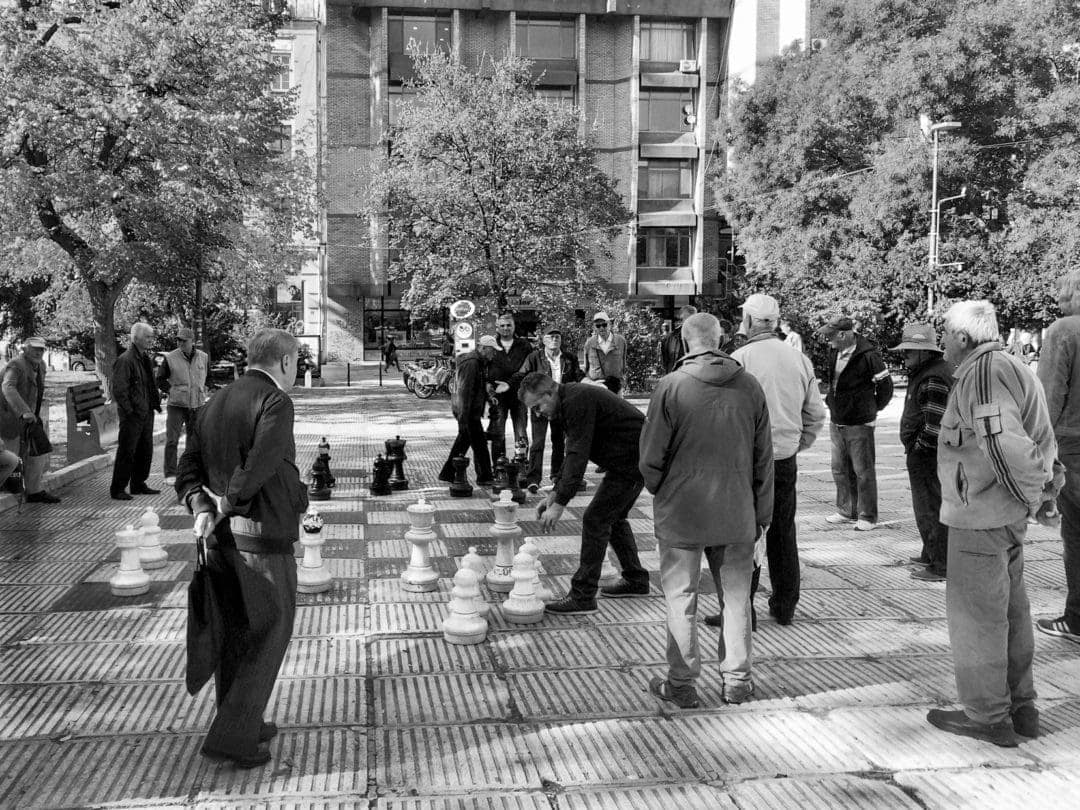
In the centre of Liberation Square stands the monument, Multicultural Man Builds the World. It was put up in Sarajevo in 1997, two years after the first identical statue was installed in Toronto.
The same statue, by Italian sculptor Francesco Perilli, is also in Changchun (China), and East London (South Africa).
Perilli describes the meaning of the monument as:
“It represents a man who, at the centre of the globe, joins two meridians; while the remaining meridians are held aloft by doves, a peace symbol in themselves. Moreover, the doves are symbolically meant to represent the cultural vitality of the people who, with the man, construct a new world, under the banner of dialogue and mutual respect”.
Francesco Perilli
There are many other monuments and statues dotted around Sarajevo.
An interesting, funny one is the huge tin of Beef, the ICAR can monument. This tin of beef was sent to Sarajevo as part of the humanitarian package during the war.
The locals say this infamous gold tin, marked ‘Beef,’ contained more jello than meat. Though they ate it out of necessity at the time, they realised it was pretty disgusting and created a monument as a “Thanks, but no thanks” to the UN.
Latin Bridge
The Latin Bridge, or Princip’s Bridge, stretches across the Miljacka River in Sarajevo. It was here, at its northern end, where Gavrilo Princip shot and killed Franz Ferdinand and his wife Sophie in 1914. This was the precursor to World War I.
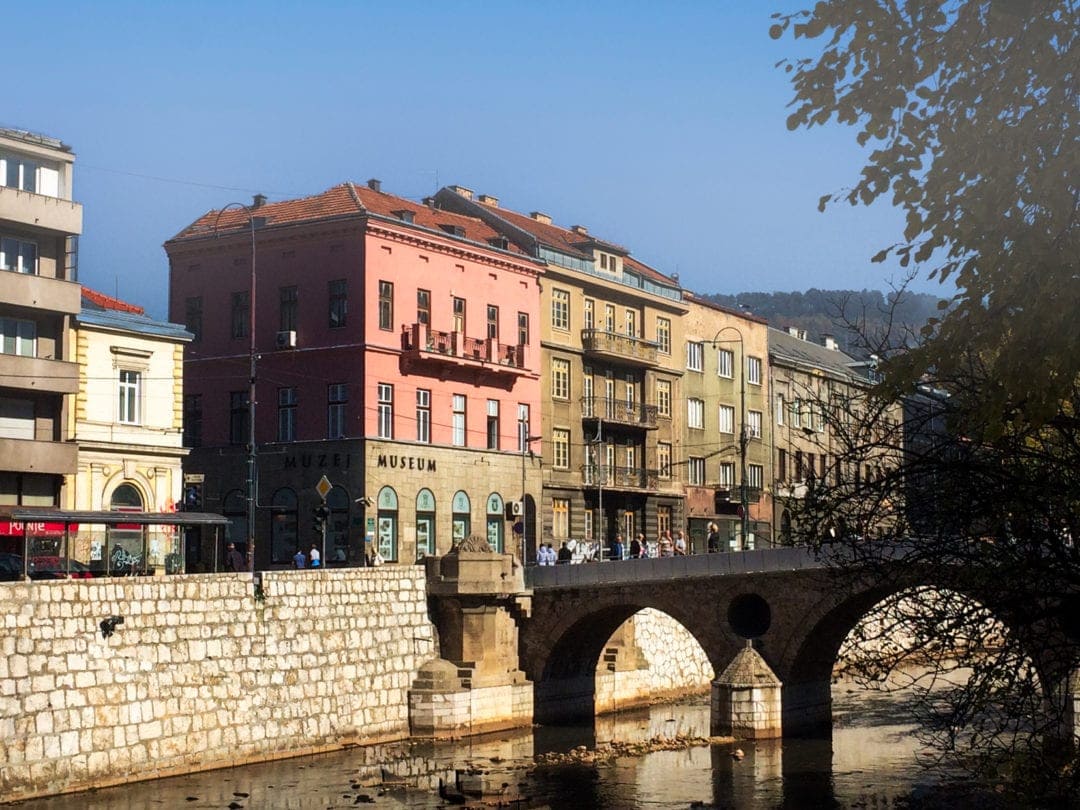
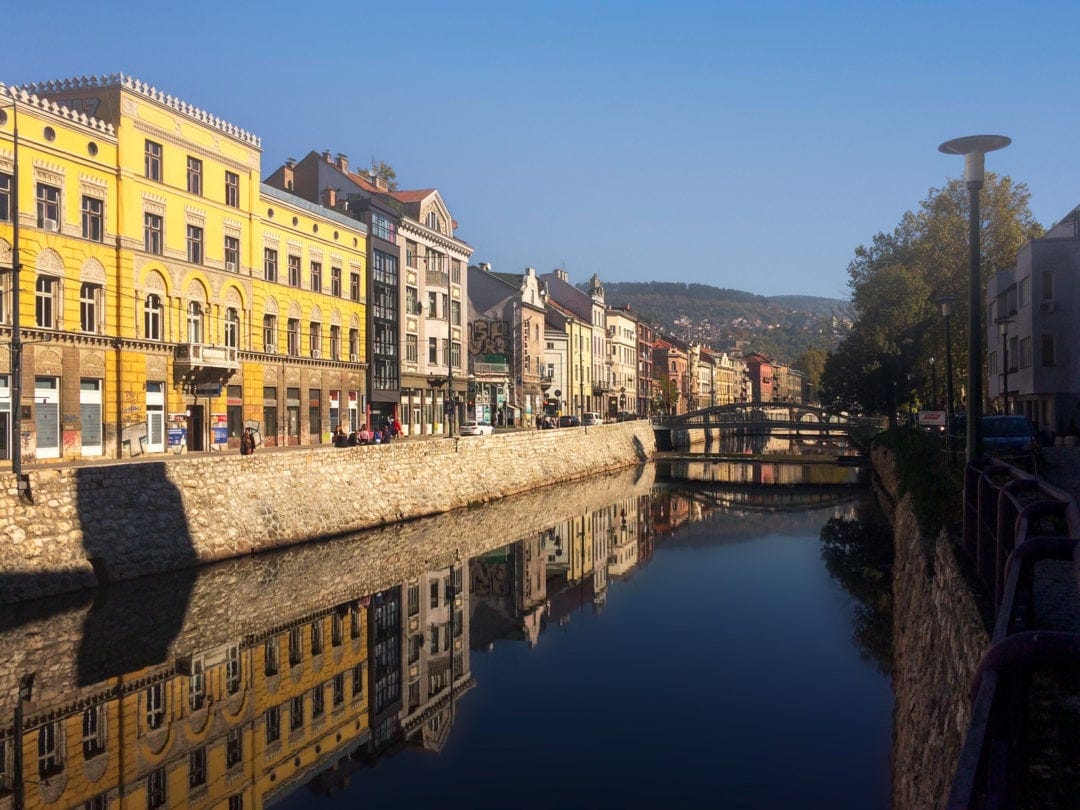
Sarajevo City Hall (Vijecnica)
The City Hall, locally called Vijećnica, was one of the most lavish buildings built in Sarajevo during the Austro-Hungarian occupation. Unfortunately, at the beginning of the siege in 1992, it was bombed and went up in flames.
At the time, it was the National and University Library of Bosnia and Herzegovina and around two million manuscripts, books and documents were destroyed in the fire.
After extensive renovations, it was finally reopened 22 years later, in 2014.

Inat Kuca
On the opposite side of the river from the town hall sits the inconspicuous Inat Kuca. Since 1997, Inat Kuca has been a traditional Bosnian restaurant. But its history started with a stubborn old man defying the powers that be.
Old Benderija, a Sarajevo local, lived in one of the houses that were to be demolished to make way for the impressive city hall. However, he refused to allow this to happen.
Finally, after many negotiations, he agreed to be compensated with a bag of gold and for his house to be moved, brick by brick, to the other side of the river. And just like that, Inat Kuca, the House of Spite, was born.
Today, the building is a protected cultural and historical heritage site.
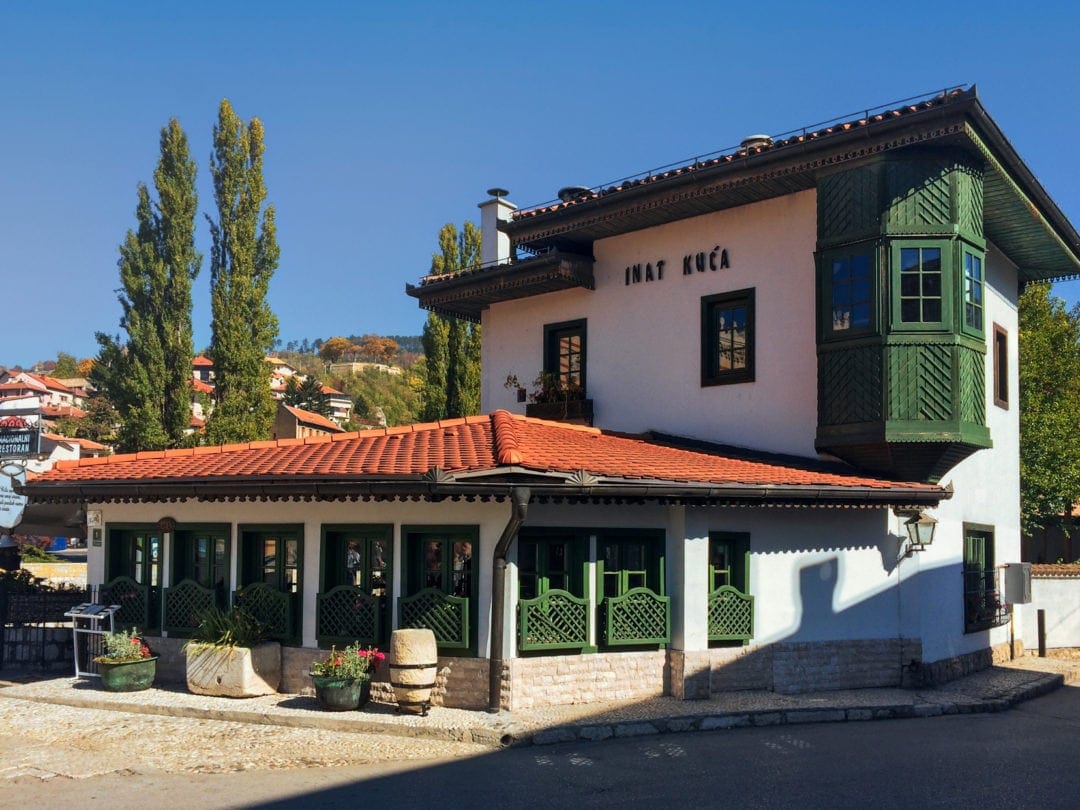
Sarajevo Cemeteries
The Kovači Cemetery is the resting place of many of the victims of the Sarajevo siege. Its narrow white column-like headstones are another poignant reminder of the terrible loss of life in the besieged city of Sarajevo.
Also, on the southern slopes of Sarajevo, you’ll find the second-largest Jewish cemetery in Europe, the largest is in Prague. The Old Jewish Cemetery is on the tentative list as a UNESCO site.
It was in use from the early 17th century to 1966. Unfortunately, it was badly damaged in crossfire during the war. Due to unexploded landmines placed amongst the graves, it remained closed until all were cleared. It eventually opened again in 1996.
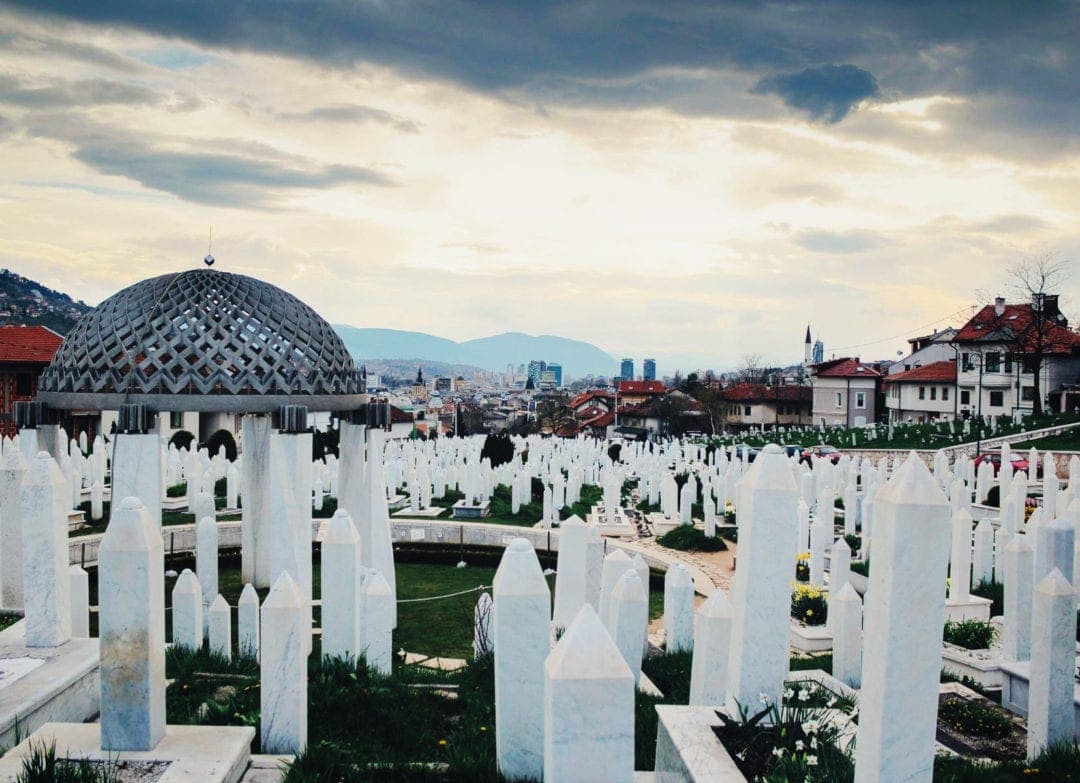
Bascarsija — the Old Bazaar
Take a stroll through the old historical centre of Sarajevo, Bascarsija. Dating back to the 15th century, this maze of narrow streets is packed with local artisans, tiny shops and cafes.
We stopped to soak up the atmosphere and sampled a couple of local dishes. For the main course, we tried Cepavi, a naan-type bread filled with small sausages, sour cream, and fried onions. For dessert, we had Tufahije and coffee.
The Bosnian coffee was very bitter — presumably an acquired taste. But the Tufahije, a poached apple stuffed with a walnut filling, was delicious.
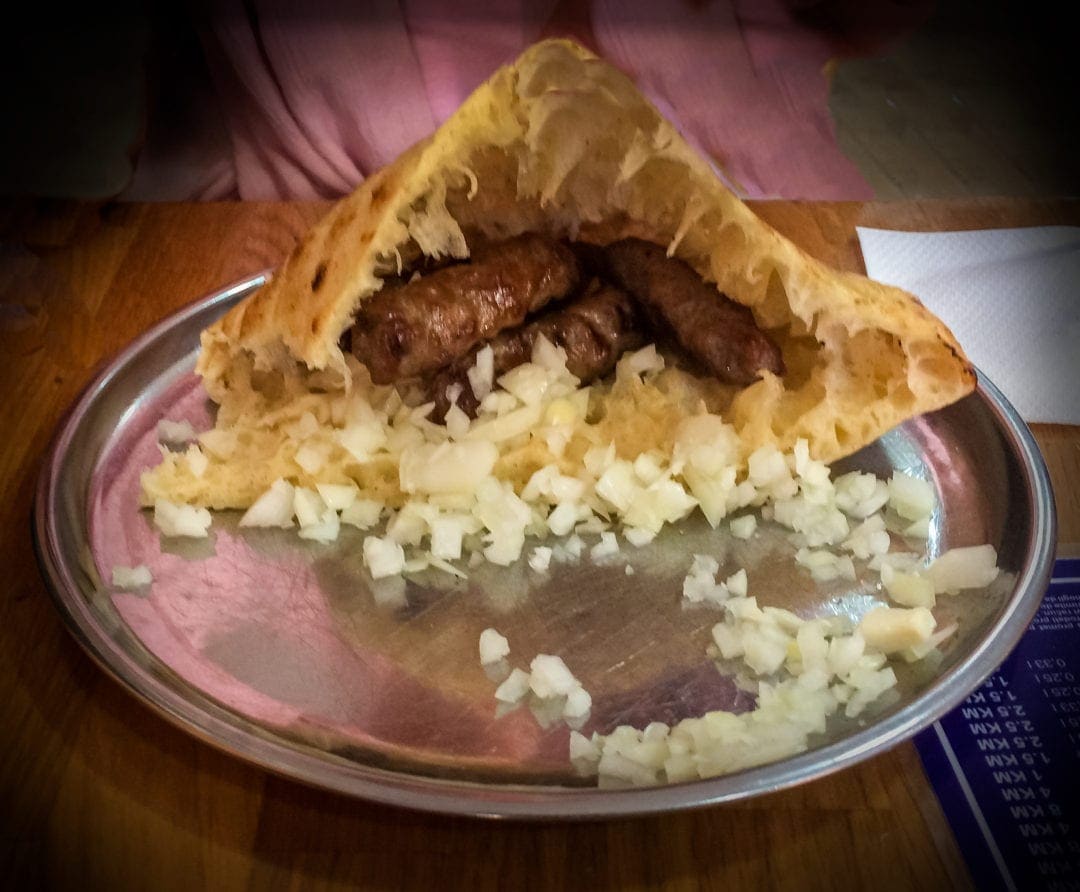
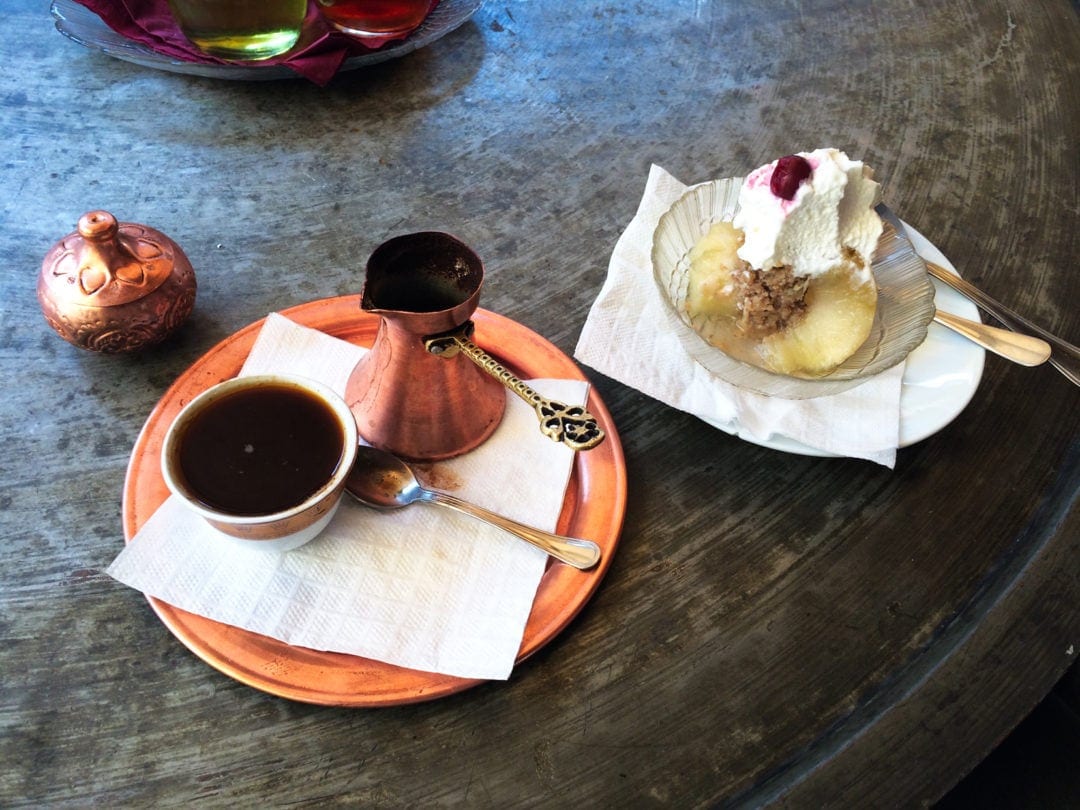
©Lifejourney4two
Sarajevo Olympic Bobsleigh and Luge
The Sarajevo luge and bobsleigh track saw victories won and ambitions dashed in the 1985 Winter Olympic Games. Unfortunately, in the Bosnian War, it was used as an artillery position, destroying the track in the process.
Wounded and battered, it now displays graffiti and attracts tourists, not for its medal-winning performance but as a reminder of modern war.
We didn’t make it here, but fellow travel bloggers Gemma and Craig of TwoScots Abroad did, and their post tells you how to get to the Sarajevo Bobsled.
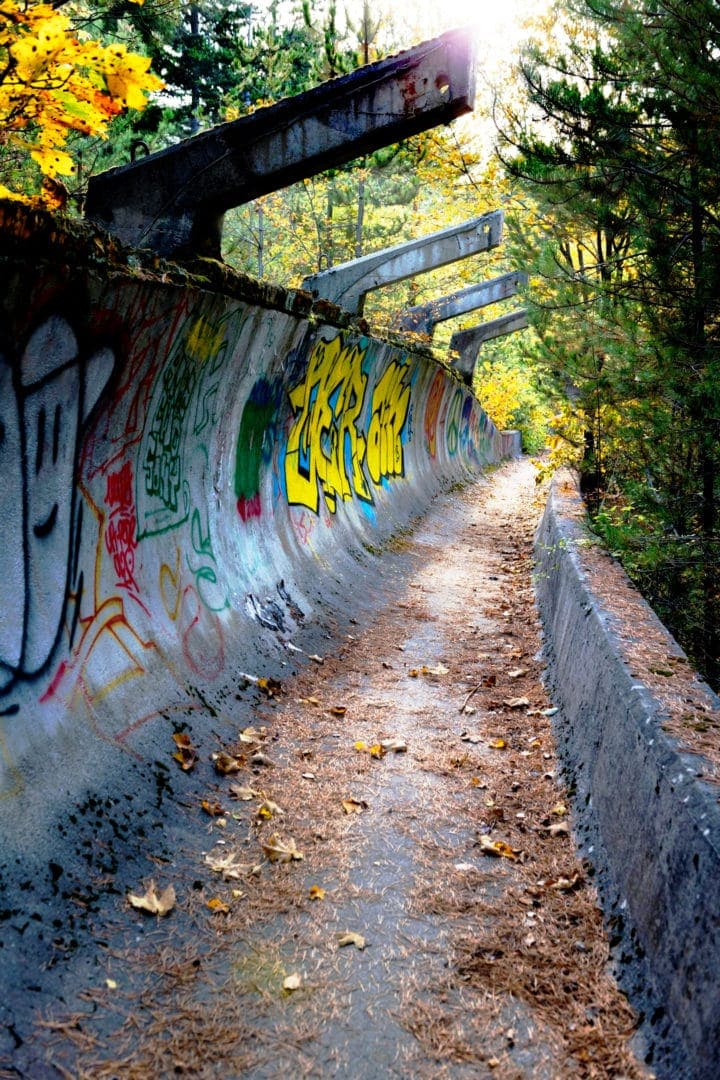
4. Mostar
Similarly to Sarajevo, Mostar is littered with derelict and pockmarked buildings, especially around Španjolski trg (Spanish Square).
In contrast to Sarajevo, Mostar Old Town, nestled between the mountains and the tree-lined Neretva River, had a more intimate feel than Sarajevo.
The Old Town, a listed World Heritage Site, is picturesque and it’s easy to spend a few hours wandering the narrow, cobbled streets.
Below, we’ve highlighted a few of the places not to miss on a stop at Mostar as you road trip Bosnia.
Koski Mehmed Pasha Mosque
Through an arched entrance leading to a courtyard, sits this small mosque dating back to the 17th century. Interesting as mosques are, it is the minaret tower with exceptional views towards the old town and Stari Most (old bridge) that is the drawcard here.
The tiny, narrow staircase of 78 steps, winds its way up to the top where you reap the reward of panoramic views across Mostar.
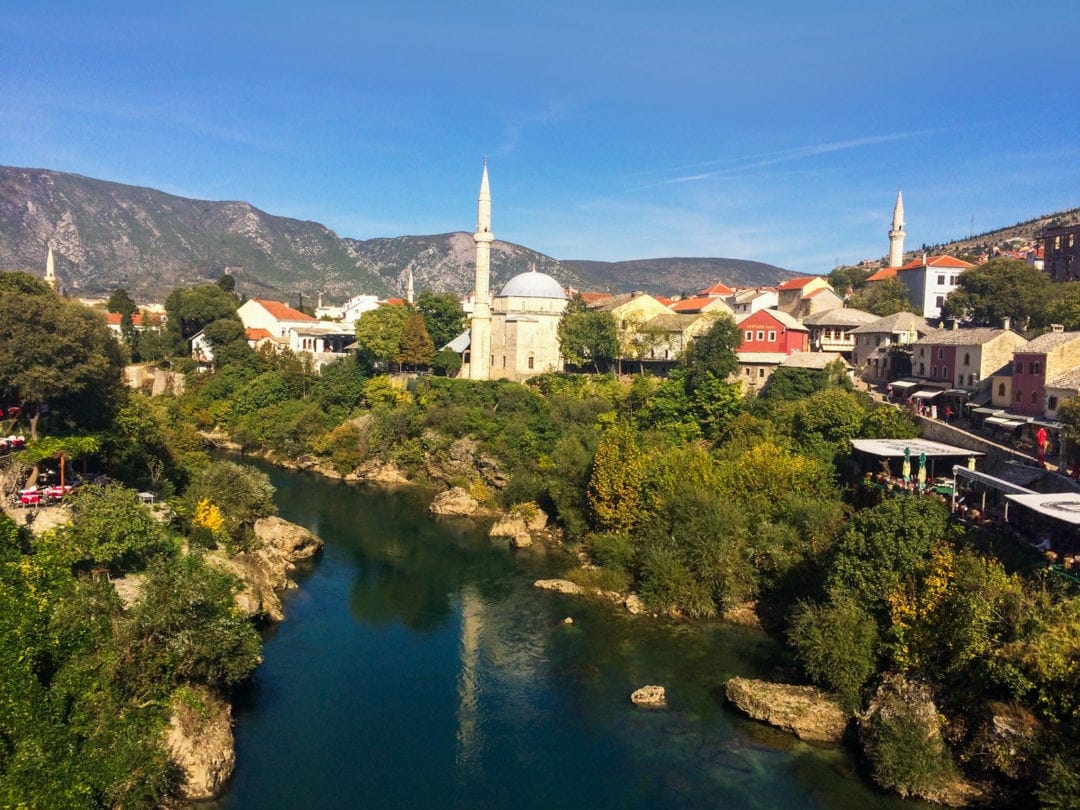
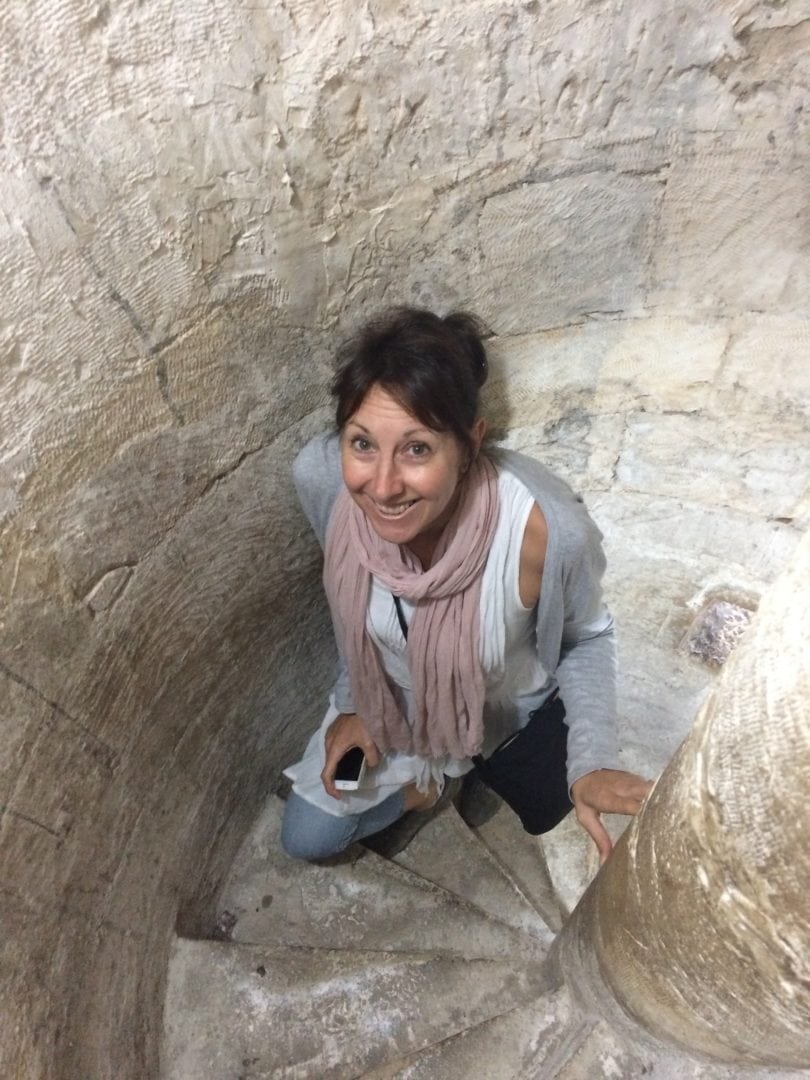
Old Bazar Kujundziluk
Between the mosque and the Mostar Old Bridge, local artisans, shops and cafes line the cobbled, narrow lanes.
This is the Old Bazar Kujundziluk, where you’ll find traditional copper workers tapping away at their intricate designs, local handmade jewellery, rugs, traditional Turkish smoking pipes, scarves, porcelain pots, and many other trinkets and souvenirs.
Stari Most — Mostar’s Old Bridge
One of the most iconic images that you will often see representing Mostar, is the view of its old bridge, Stari Most. The bridge was originally built over the Neretva River in the 15th century when the town developed in Ottoman times.
However, during the Bosnian War, much of the Old Town and the bridge were destroyed.
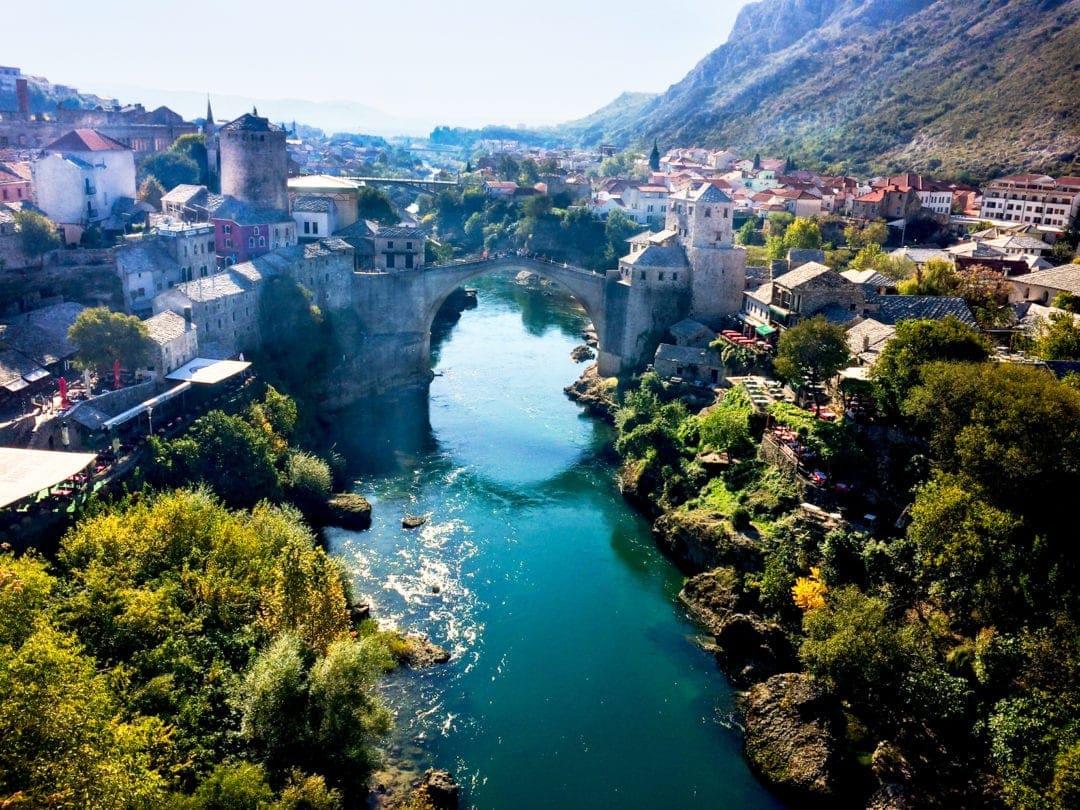
As an example of a multi-cultural urban settlement, the bridge and many parts of the old town were rebuilt by a committee established by UNESCO. Now on the World Heritage List, the bridge and old town are;
…a symbol of reconciliation, international co-operation and of the coexistence of diverse cultural, ethnic and religious communities.
UNESCO
A regular spectacle on the bridge is young men standing on the edge of the bridge’s railings, looking like they are about to jump.
They collect money from onlookers, and when they believe they have amassed enough, they jump into the river below.
Be mindful that their charade can go on for hours, with several false starts and teasing of eager tourists at the ready with their cameras.
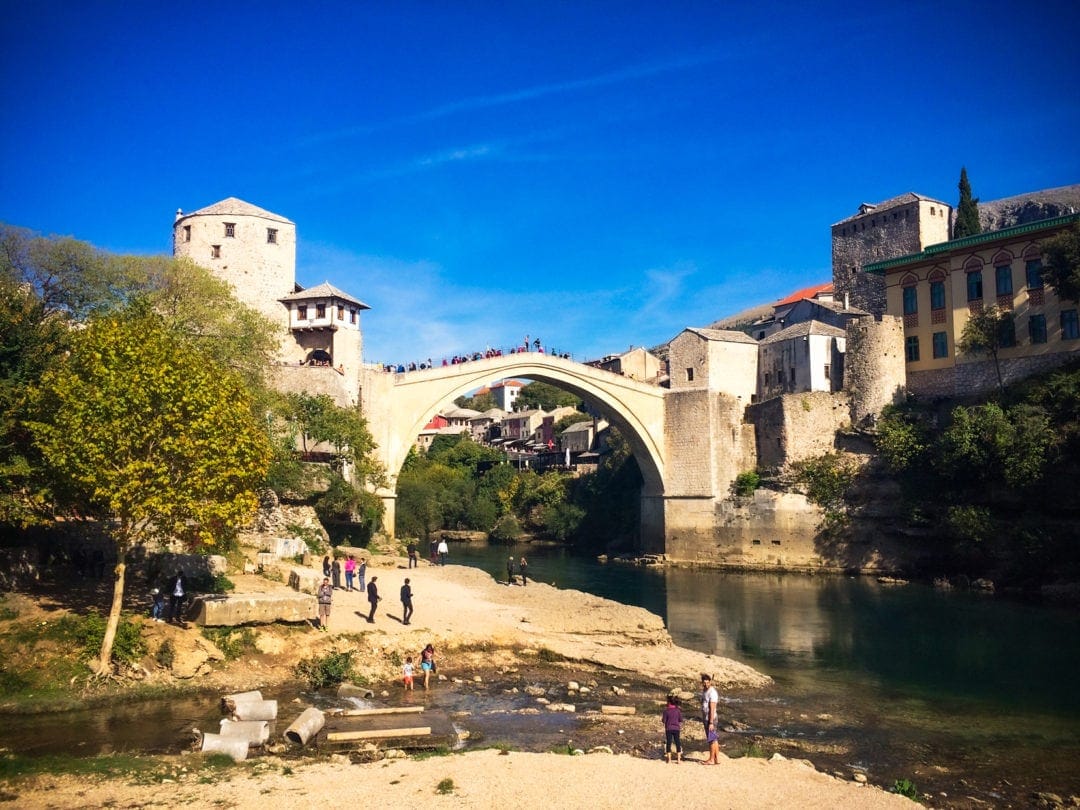
Mostar’s Crooked Bridge (Kriva ćuprija)
This cute little bridge was built as a smaller trial version of the Stari Most. It, too, has been rebuilt due to structural damage in the war and floods.
Locals told us that local cafes play music here at night, so it might be a nice place to hang out if you are in Mostar for the evening.
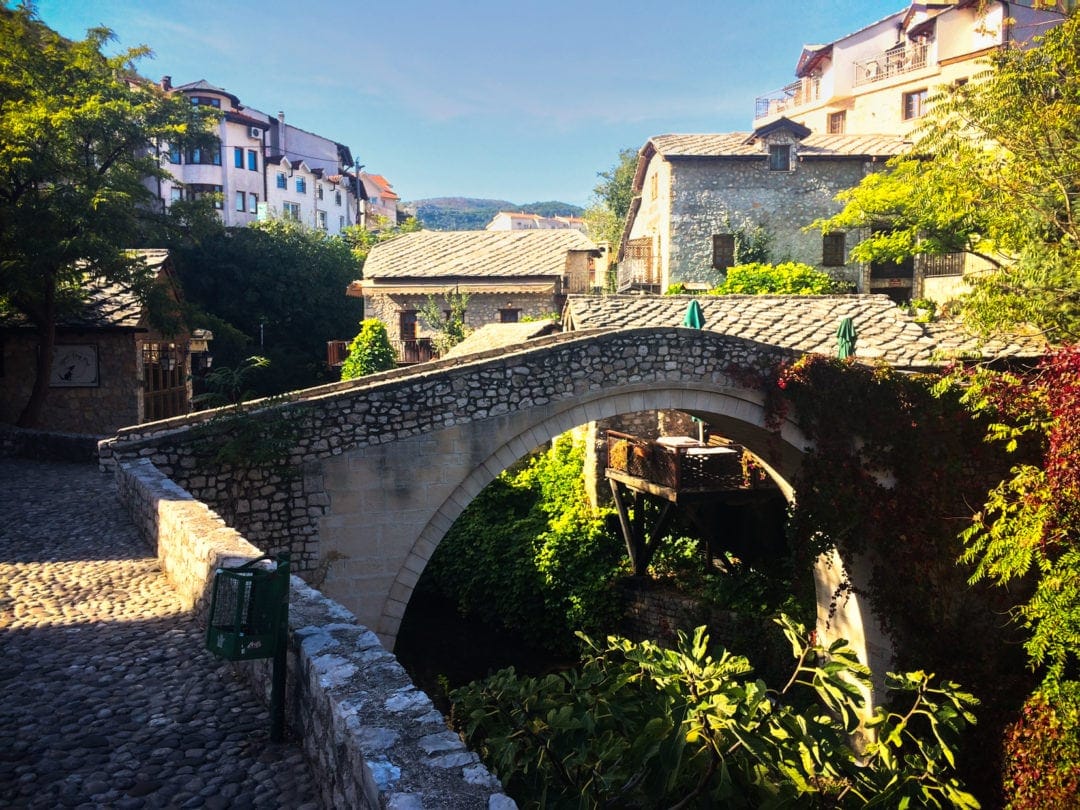
Mostar Sniper Tower
The Mostar Sniper Tower was once a bank, but in the Bosnian War, because of its high vantage point was used as a sniper tower.
It now stands derelict as a painful reminder of the conflict. You’ll find many bullet-ridden and derelict buildings as you wander around Mostar and elsewhere in Bosnia. Although boarded up, graffiti artists now use the tower as a canvas to express their creativity.
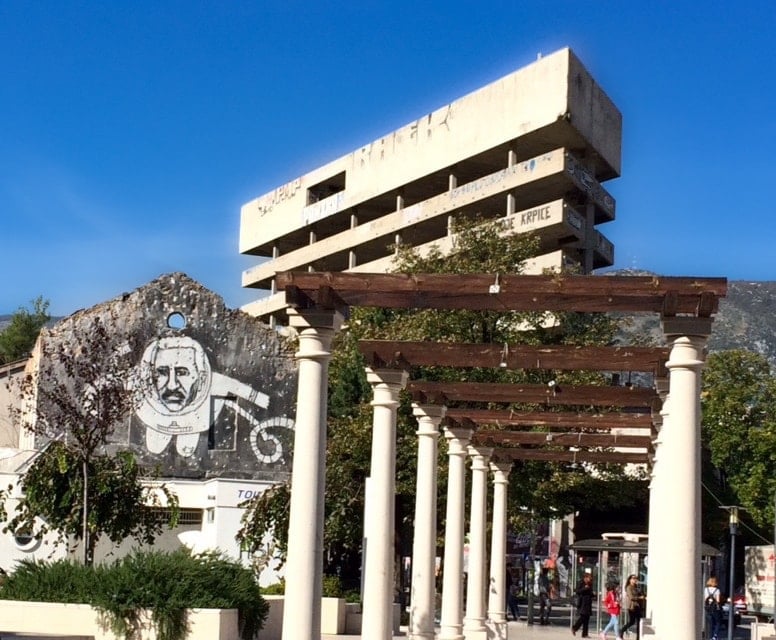
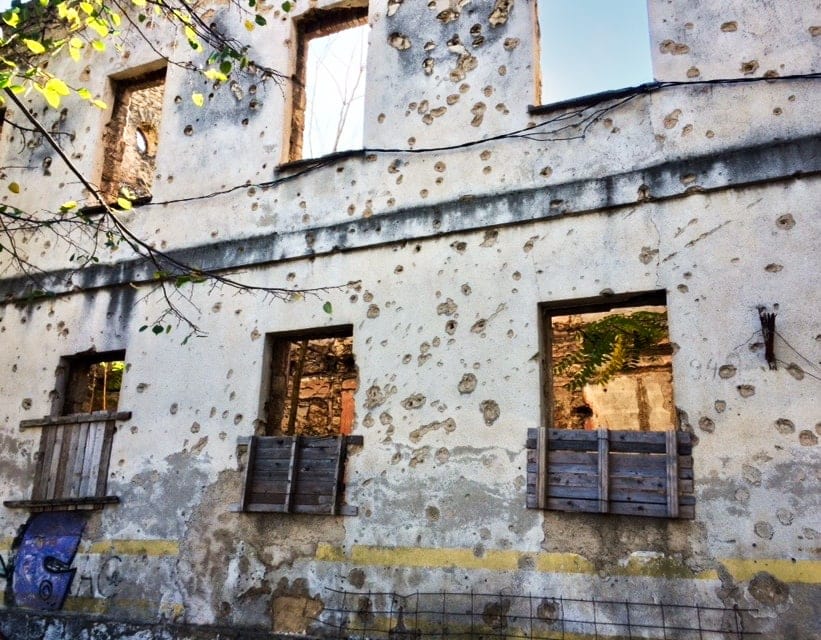
5. Blagaj Tekke
Not far from Mostar is the gorgeous River Buna, which has its source in an underground cave spring in Blagaj. Situated right at the entrance to the cave at the bottom of a steep cliff face is the ancient Dervish Monastery, the Blagaj Tekke.
To visit inside, you do need to take your shoes off and cover up, but it’s an interesting building to explore, covered with carpets and cushions. It’s cool, calm, and peaceful inside, and its setting is spectacular.
Constructed in the early 1500s, the Blagaj Tekke was for those of the Dervish faith—a branch of Islam that took a vow of poverty and rejected material possessions. The Dervish were well-known for performing whirling dances as part of their worship, with white costumes that fanned out as the Dervish spun themselves around.
A few cafes are nearby for refreshments and to soak up the calming atmosphere.
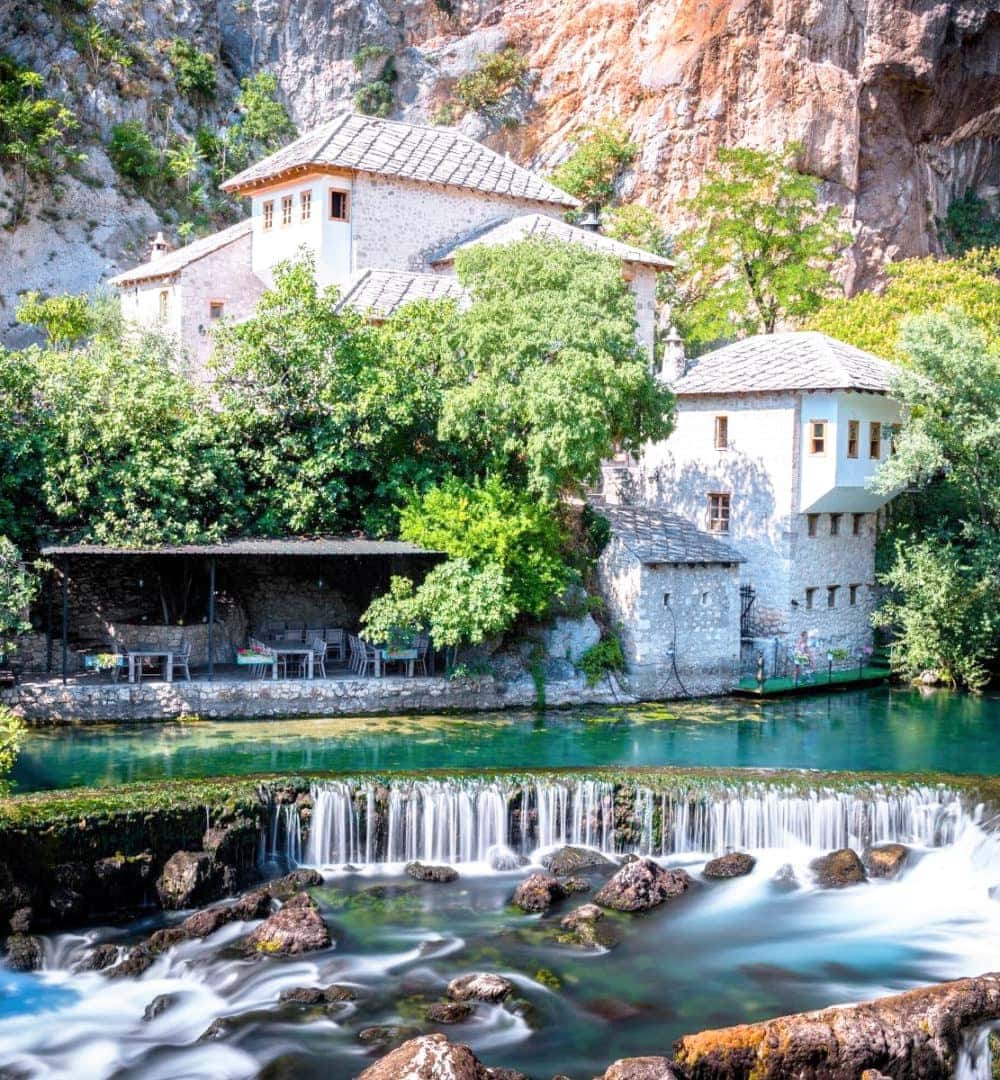
6. Kravica Waterfall
About 30 minutes from Mostar, this pretty waterfall is worth a stop on your Bosnia road trip, especially if you get there early before the crowds. Its appearance is a little like Krka Waterfall in Croatia and you are also allowed to swim here.
The Kravica Falls are 25 metres high and the arc-shaped cascades flow amongst luscious greenery.
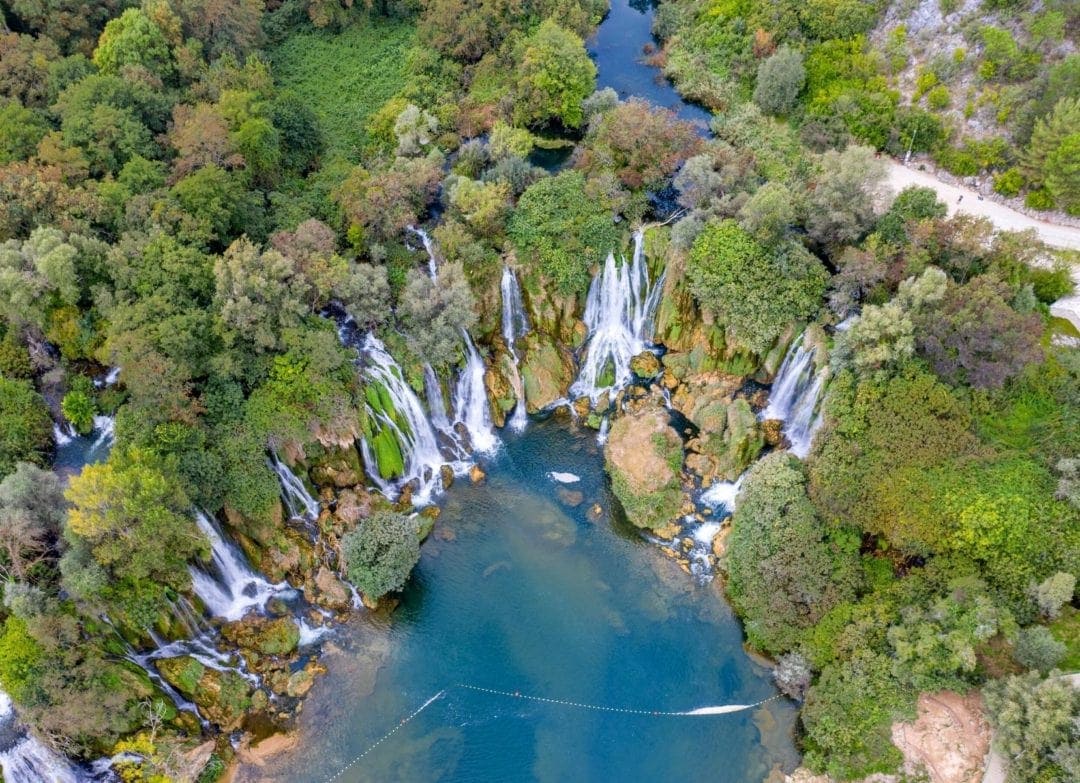
After road-tripping through Bosnia, we headed off to road trip Serbia.
However, the Croatia border is only a short distance from Kravica Falls, so it would be easy to continue your road trip through Croatia. From here you could easily head north to Split or south to Dubrovnik.
Campervanning and Motorhoming in Bosnia
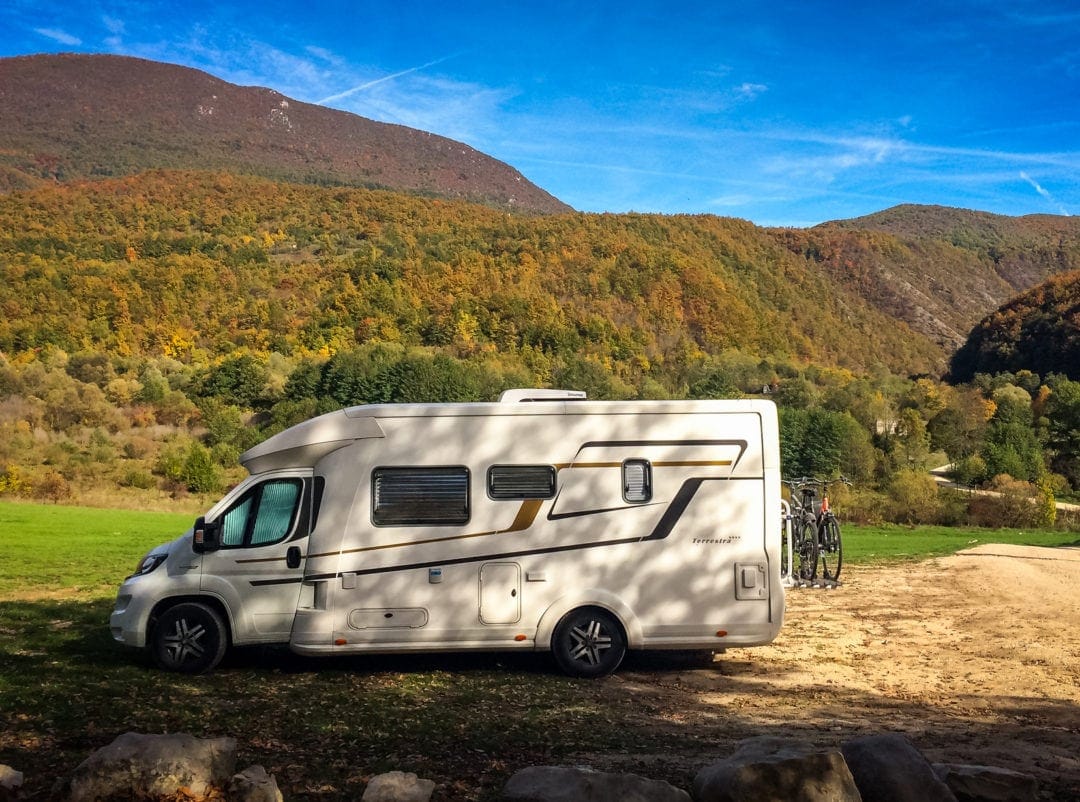
Tips for Campervanning in Bosnia
- For general motorhome tips, you will find these posts useful:
- Our Europe by Campervan article will also give you many helpful pointers for driving in Europe.
- In regards to finding campervan overnight stops in Bosnia, we found Campercontact to be invaluable.
- Wild camping is tolerated – but don’t drive off road as Bosnia still has unexploded landmines.
Bosnia Campervan and Motorhome Rental
On our travels through Europe, we found that the Motorhome Republic was able to negotiate a much better deal than we could get when we tried going to the motorhome rental companies ourselves. In addition, they did all the hard work!
💥 Looking to HIRE a motorhome or camper? We used and highly recommend Motorhome Republic. They have an EXCELLENT rating on Trustpilot, and their customer service was amazing.
Our Campervan / Motorhome Stops in Bosnia
- Una National Park: Camp Buk — Beautiful spot by the river and friendly owner who was keen to share his home-brewed Rakia (A strong fruit brandy-like drink)
- Jajce: We overnighted in a car park (44.33703, 17.26819) and paid ten euros but it was so noisy we wouldn’t recommend it. There is a campsite nearby @ Autocamp Plivsko Jezero
- Sarajevo: Camping Sarajevo — We drove into Sarajevo straight from Jajce, but if you stay at this campsite you could get a taxi or reviews state that the owner is willing to give a lift.
- Mostar: Camp Buna — ***** Excellent camper stop with a super friendly host, Gaga, and opportunity for lifts to Mostar and Blagaj.

Wild Camping in Bosnia
Although not officially sanctioned, wild camping is tolerated in Bosnia. However, there are unexploded mines around the countryside, so don’t go off road.
Accommodation in Bosnia:
If you are looking for accommodation in Bosnia, try these deals on Booking.com
Driving in Bosnia
Many rural roads can be in poor condition, but the major routes are fine.
- In Bosnia, you drive on the right
- Seatbelts are compulsory
- You will need to have the following documents:
- Drivers licence (An international driver’s licence isn’t required)
- Vehicle insurance
- Vehicle registration document
- Passport
- Note: Since August 2021, you no longer need a Green Card for Bosnia
- You are also required to have the following in your vehicle:
- The use of speed camera detectors is prohibited
- Anyone under the influence of alcohol can’t sit in the front seat, even as a passenger
- If you’re involved in an accident, you must wait until the police arrive
- Driving in Bosnia requires adjusting the beam pattern to suit driving on the right so that the dipped beam doesn’t dazzle oncoming drivers. You can purchase inexpensive beam deflectors to adjust the beam.
- Dipped headlights must be used at all times, day and night
- Trams on the left have priority
- Bosnia Toll Roads: There aren’t many toll roads in Bosnia, just the A1 around Sarajevo and at the border with Croatia in the south. To avoid them, you can program your navigator to avoid tolls. Tolls are collected at the toll gates and can be paid by cash or credit card
- Speed Limits are as follows unless otherwise signposted and on dry roads
- 130 km/h (80 mph) on motorways
- 100km/h on dual carriageways
- 80 km/h -100 km/h (50 mph) outside urban areas
- 50 km/h (31 mph) in towns and cities.
- Never drive off road in rural areas, as Bosnia has many unexploded land mines
- Emergency Number: 112
Handy Information for Your Bosnia Road Trip
- Currency: Bosnian Mark (BAM)
- Handy Bosnian Words:
- Thank you = Hvala (HVAH-lah)
- Good day, hello = Dobar dan
- Goodbye = Ćao (Chow)
- Yes = Da
- No = Ne
- Health: Water is safe to drink from the tap
Campervanning in Bosnia … That’s a Wrap
As I wrap up this post, I am a mixture of sadness for what happened in Bosnia and Herzegovina and hope for its future.
A country with so much beauty needs to be shared with the world.
Tourism is one of the ways that will help the country recover. Indeed, telling their stories to tourists, on their Sarajevo city tours, is how Neno and friends make their living.
Lakes, mountains and waterfalls are calling, and there are so many interesting places that a Bosnian road trip can take you.
Read more:
- Road Tripping Around the World
- Austria by Campervan
- Slovenia Road Trip: Campervan and Motorhome Guide
- Albania Road Trip: A Country of Surprises
- Campervan Greece Road Trip
- Road Trip Quotes and Inspiration
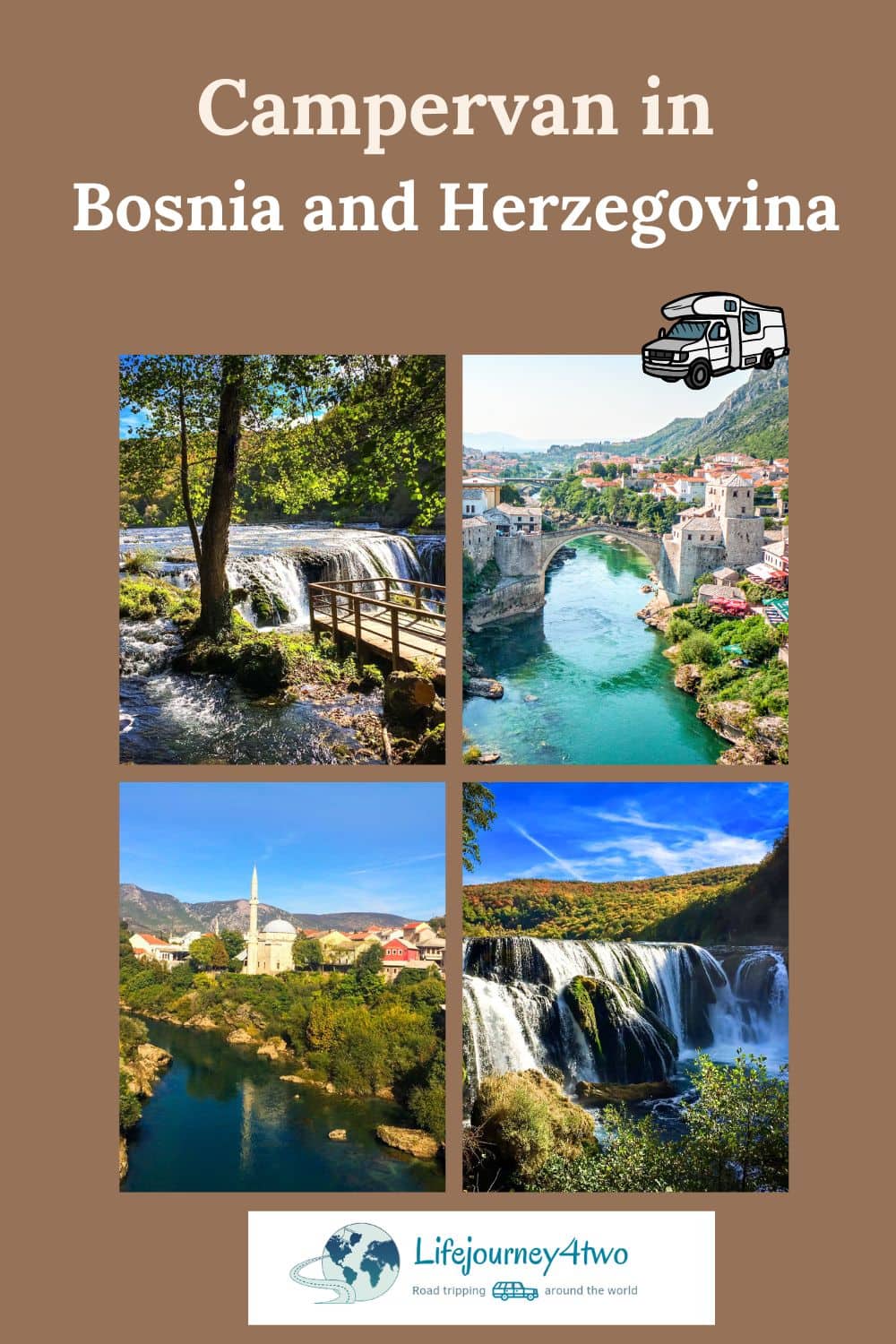
Planning Your Travels?
These are the travel resources we recommend and use when planning our trips.
- 🚘 Car Hire: We use DiscoverCars.com
- Motorhome/Campervan Rental: We highly recommend the Motorhome Republic
- 🪪 Order your International Driver’s Licence online here
- 🛏 Book Accommodation: We use Booking.com to find accommodation that suits our budget
- 🐶 Pet Sitting/Pet Sitters: Check Out TrustedHousesitters here (Use our Discount code: LIFEJOURNEY25 for 25% off. )
- Activities and Experiences: Get Your Guide and Viator
- Travel Insurance: Safetywing or World Nomads
- 🥾 Travel Gear and Accessories: Check out our top picks here — Lifejourney4two page on Amazon
For a more thorough list, visit our Travel Resources page here.

